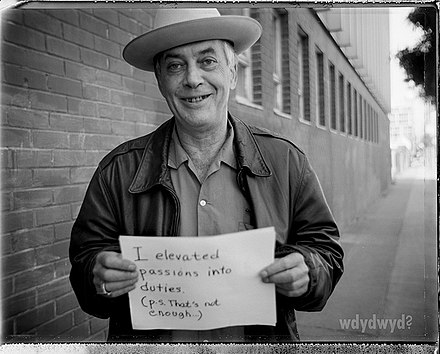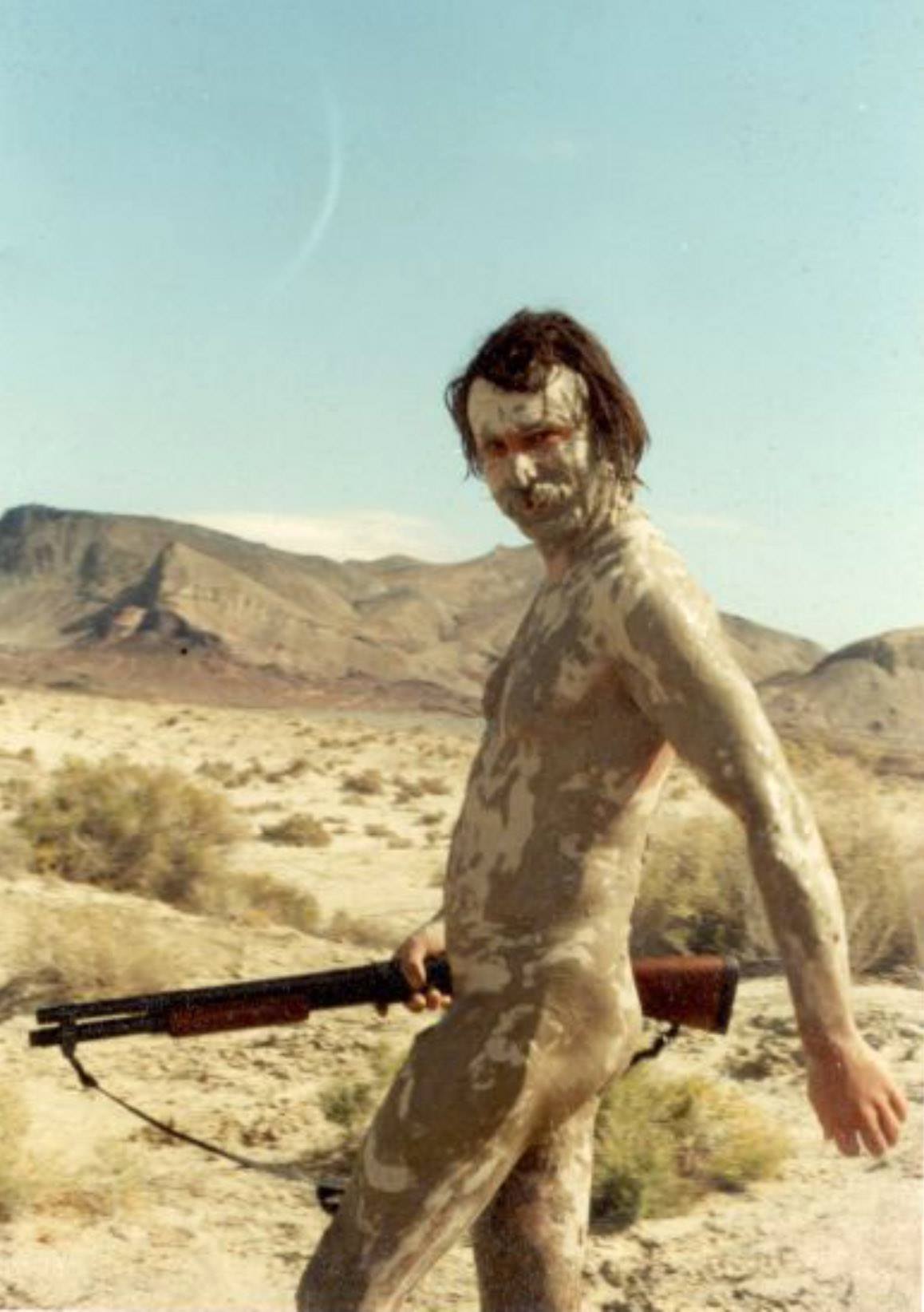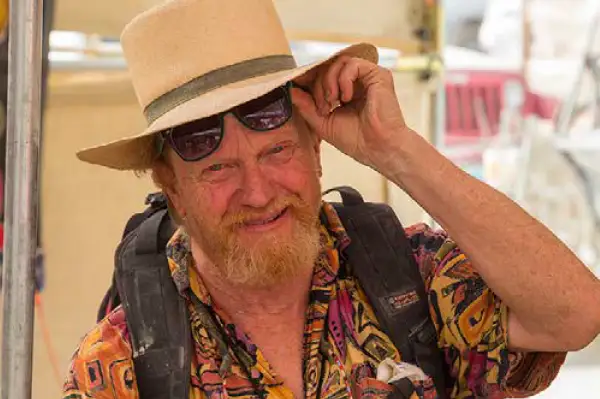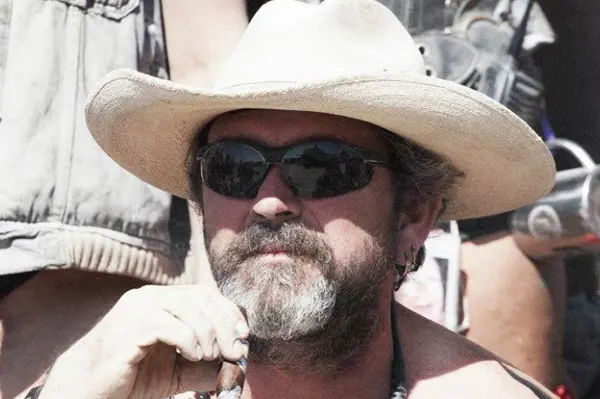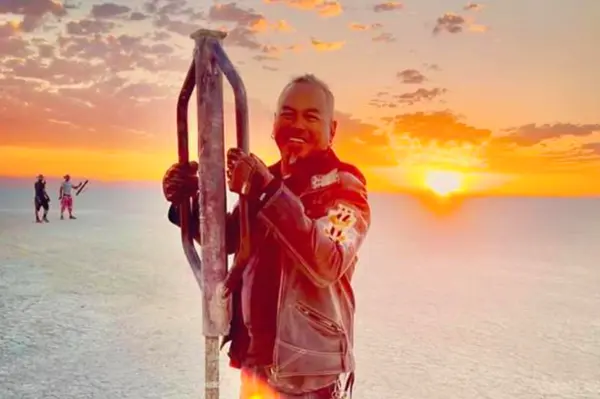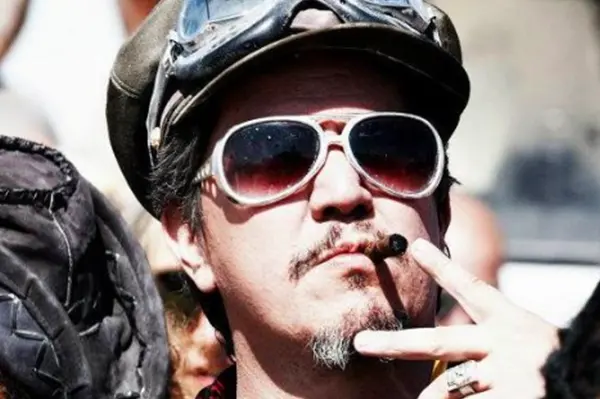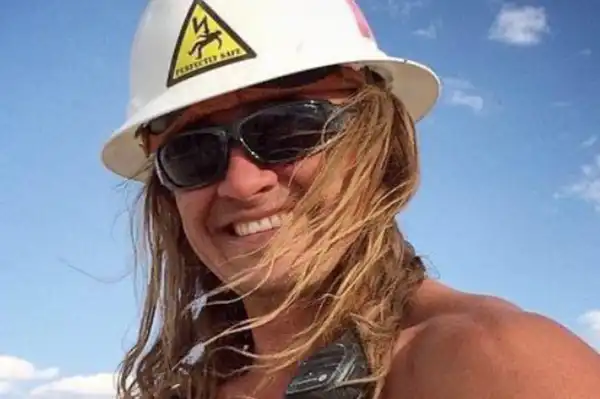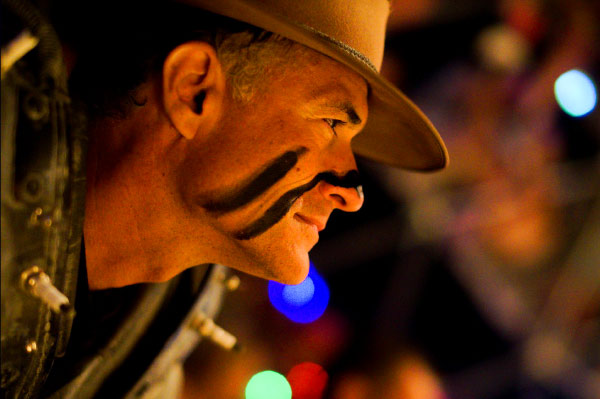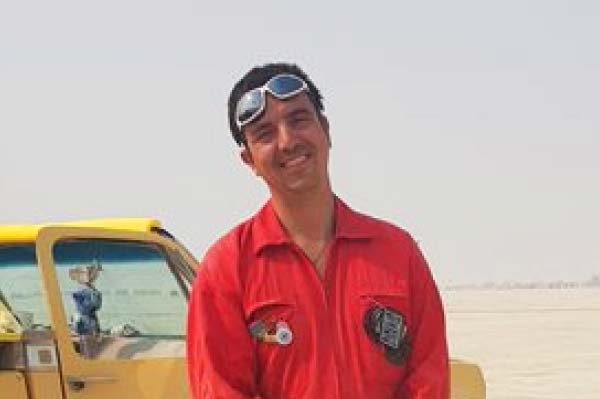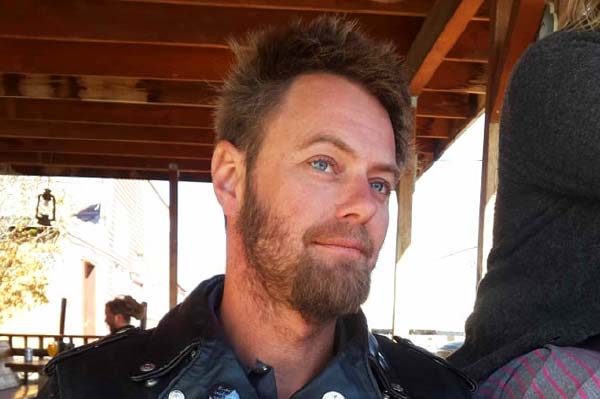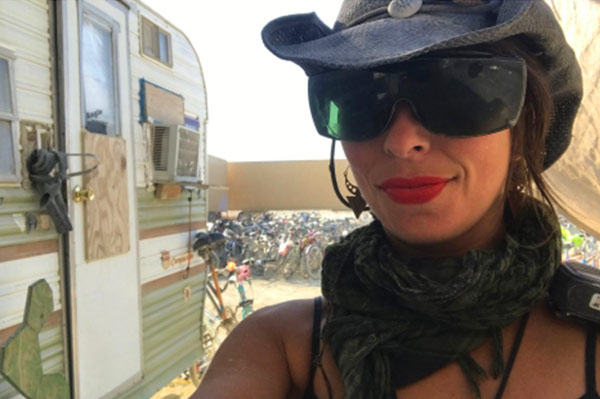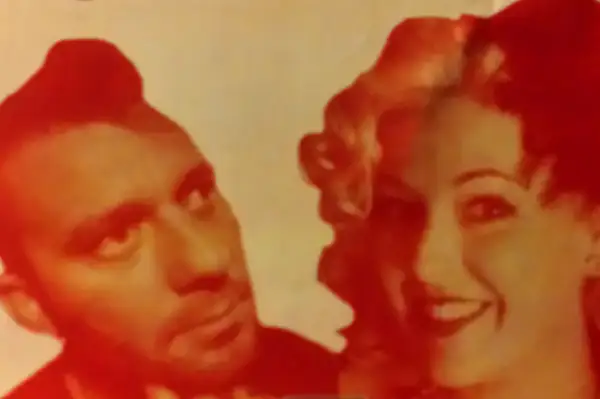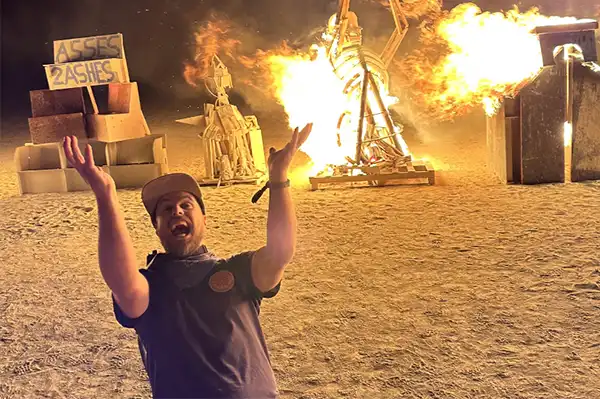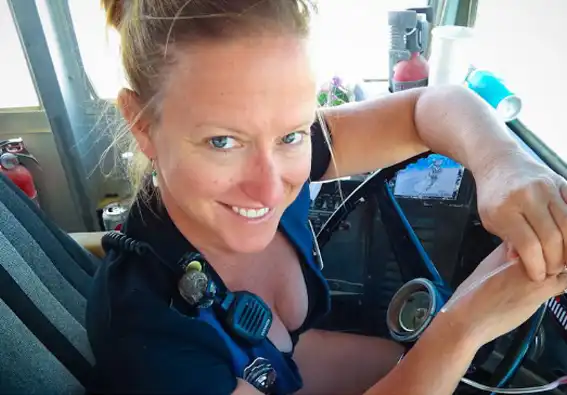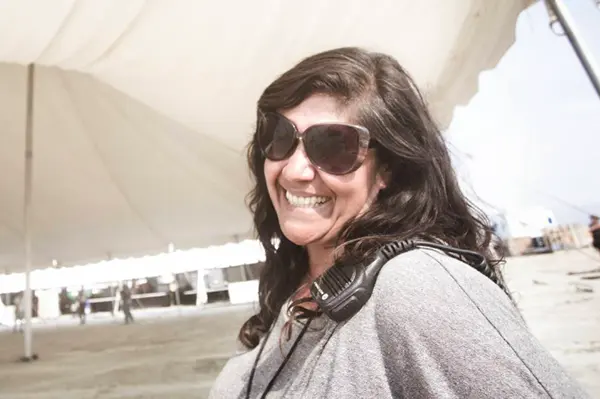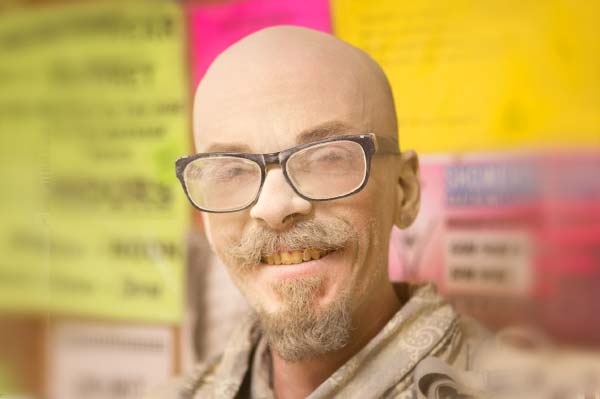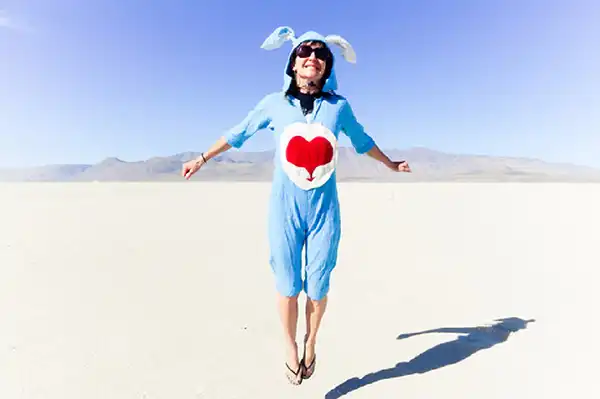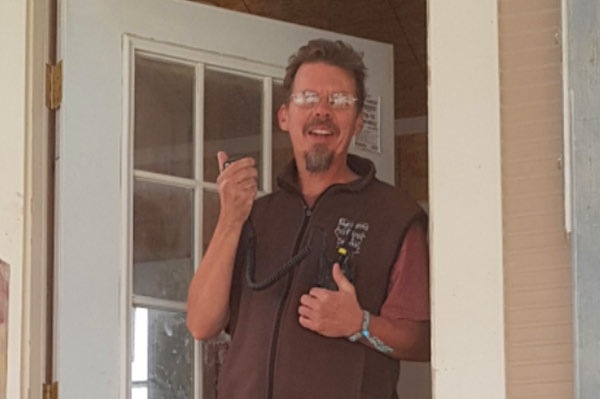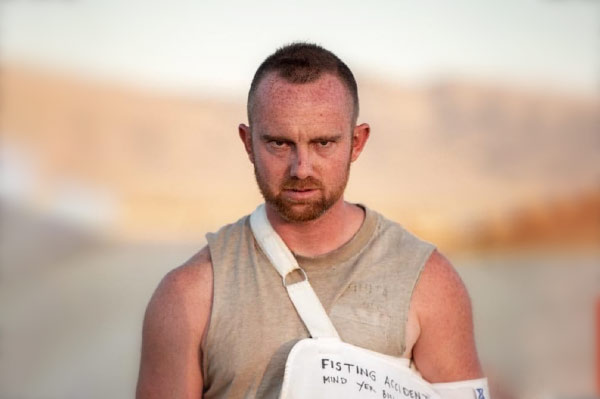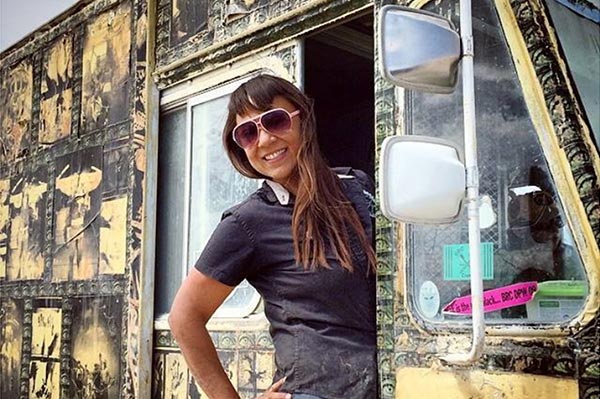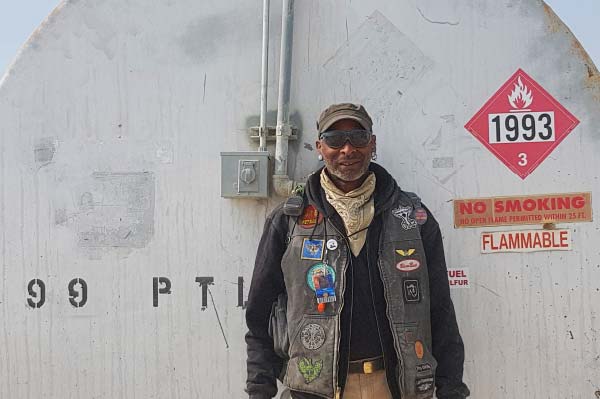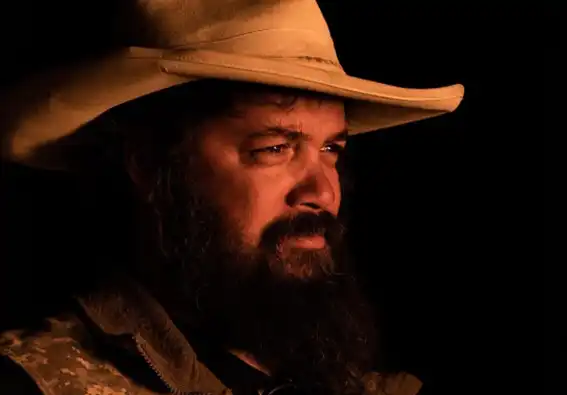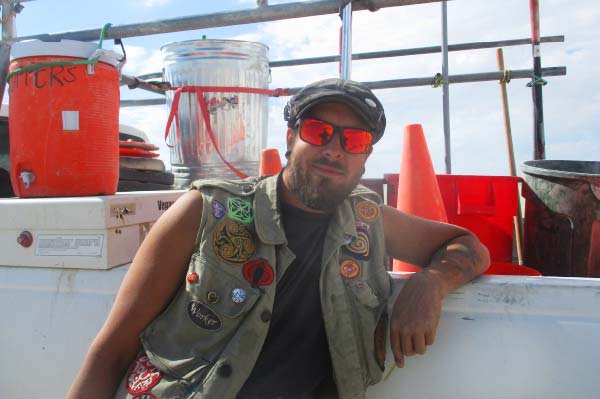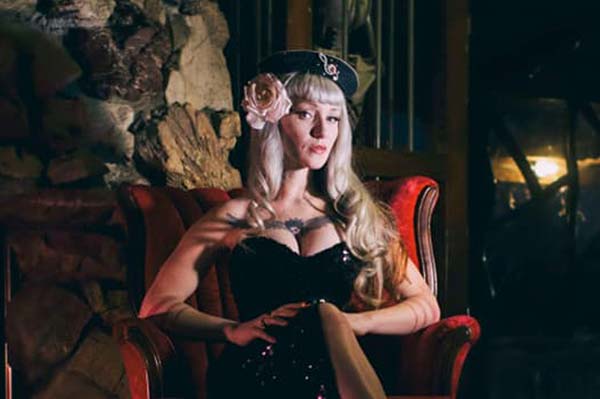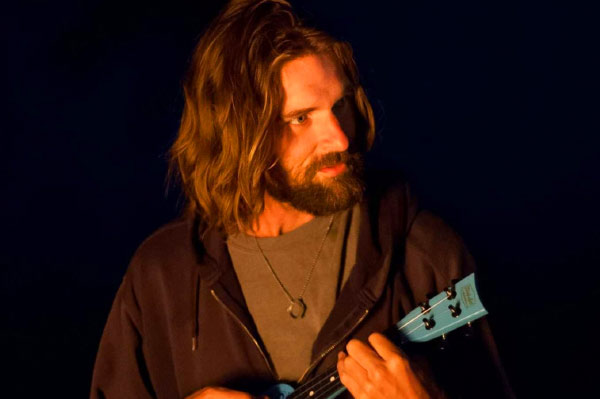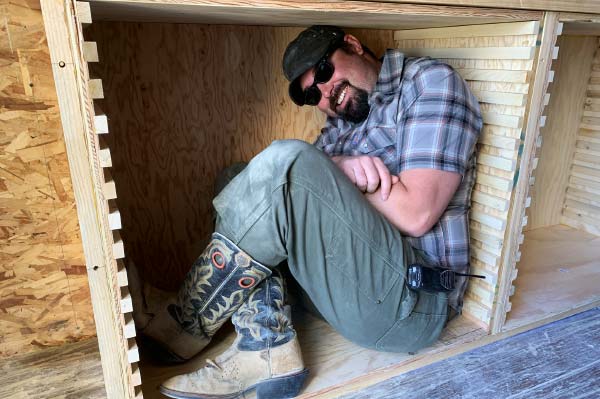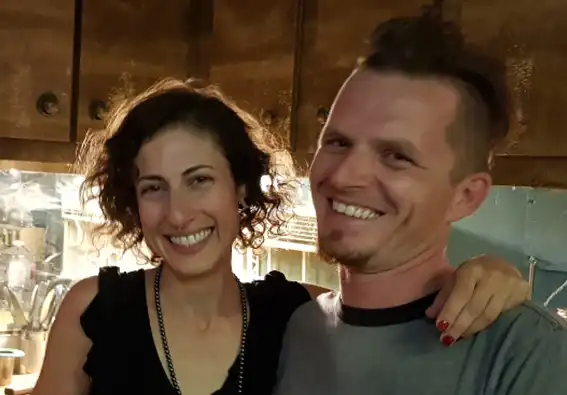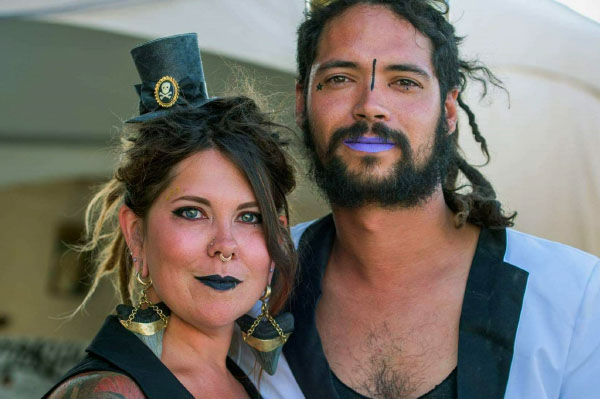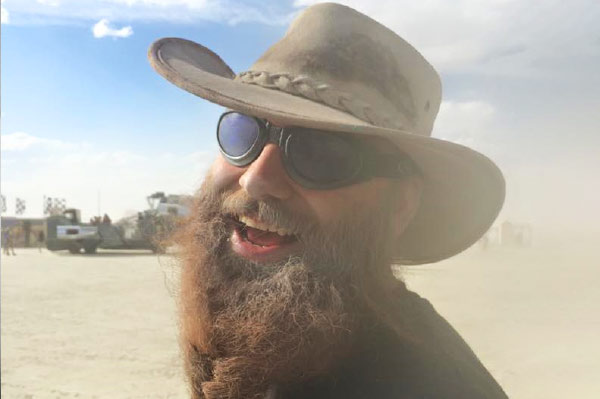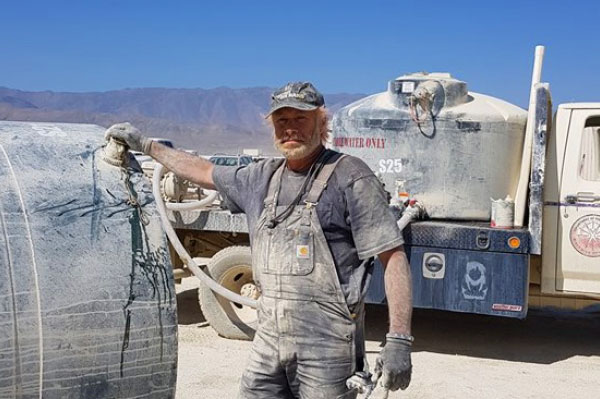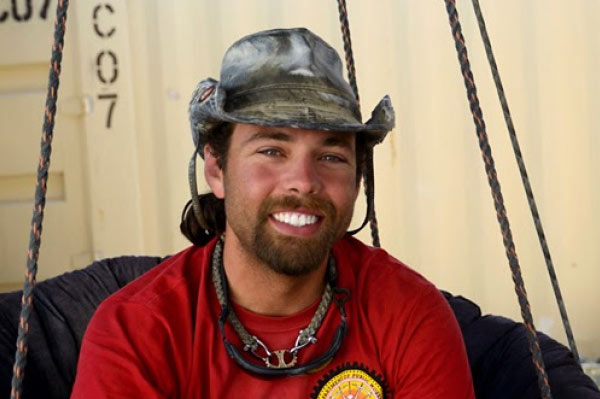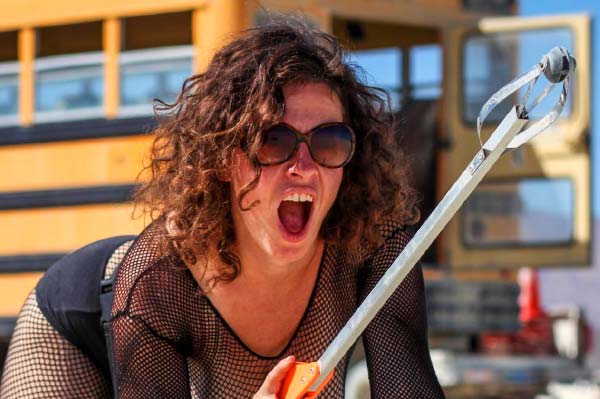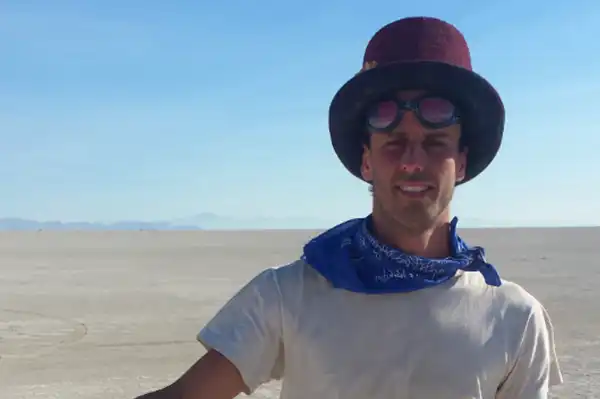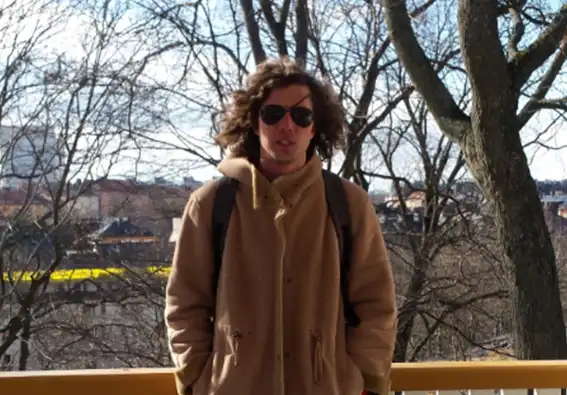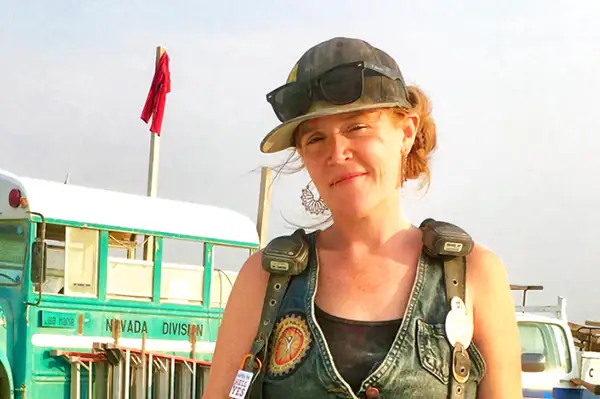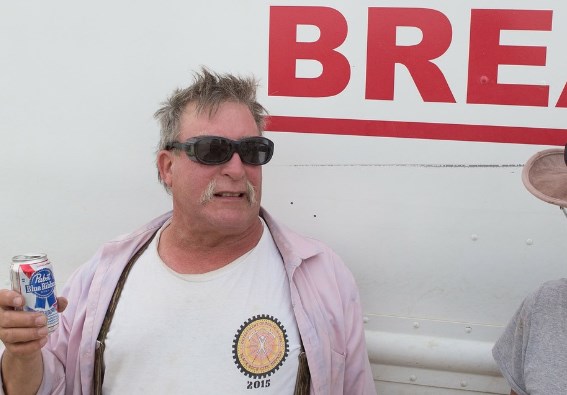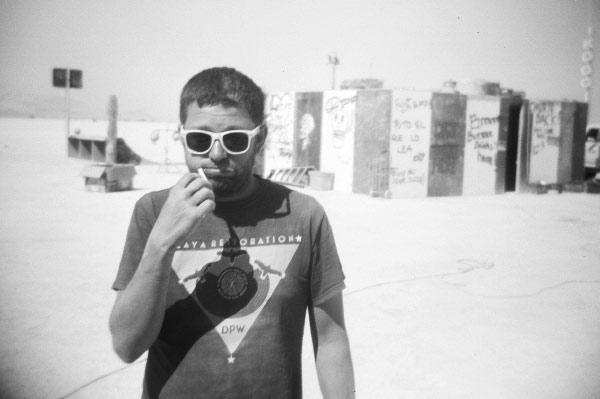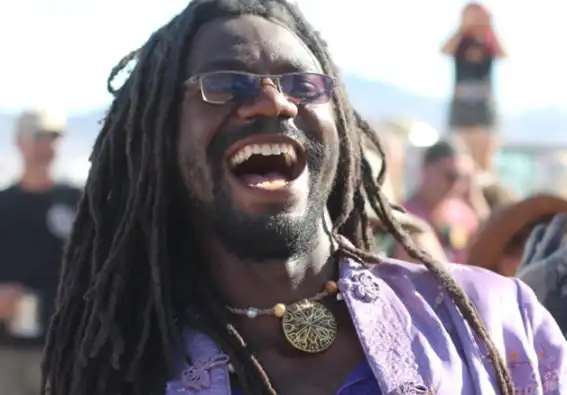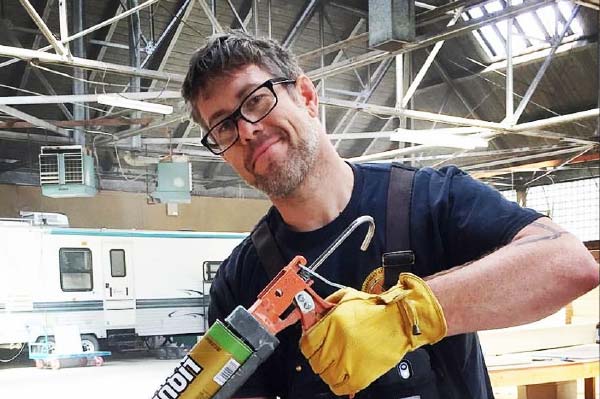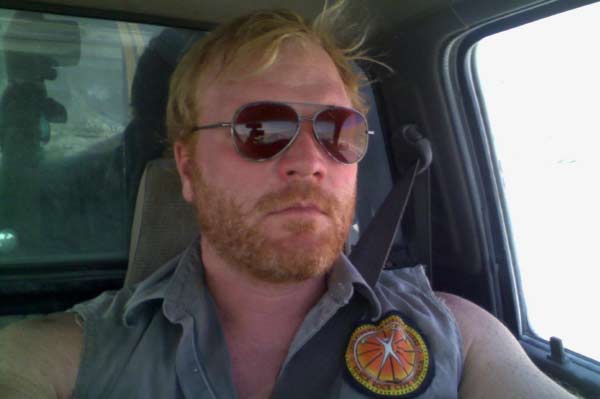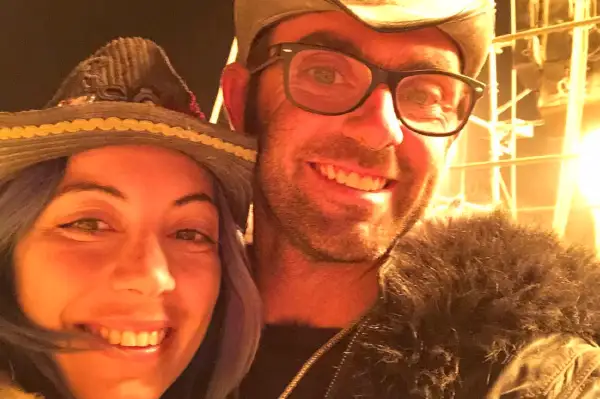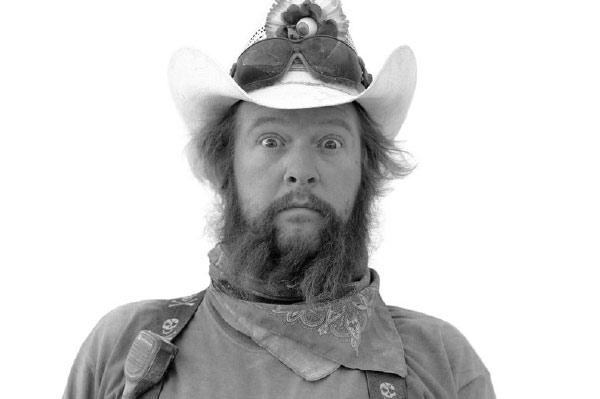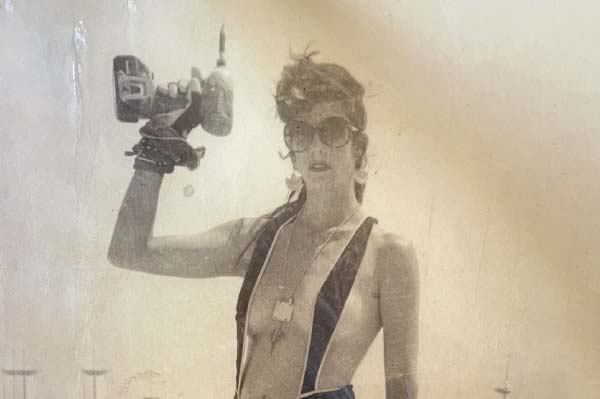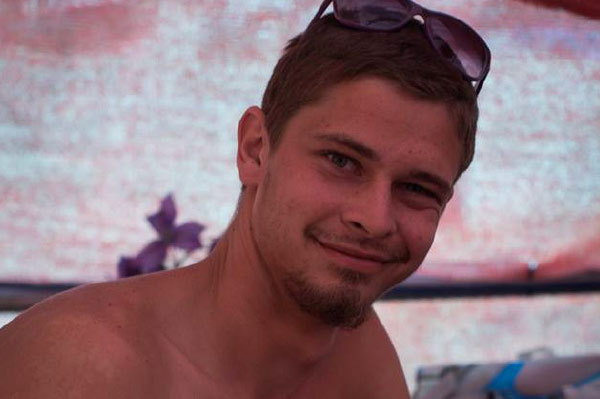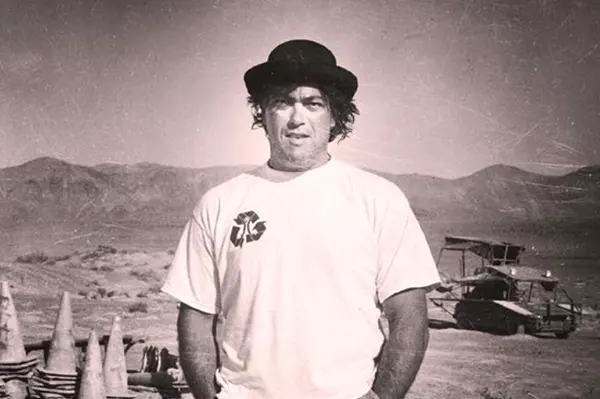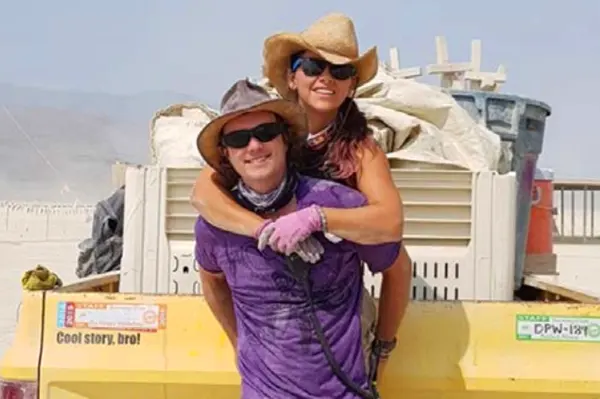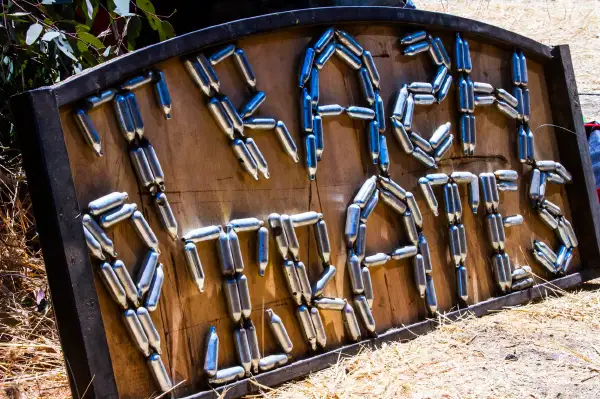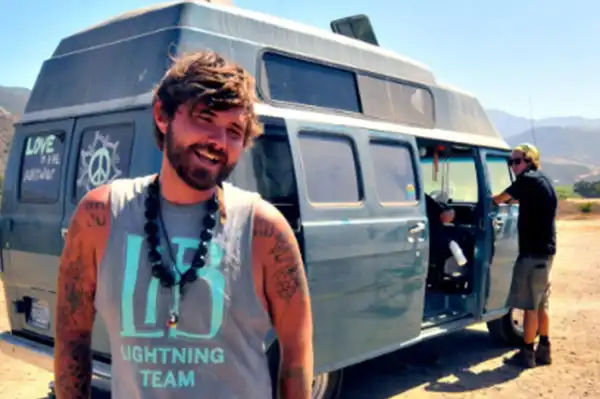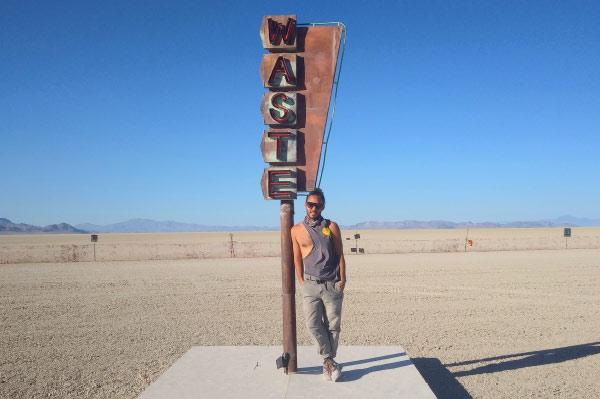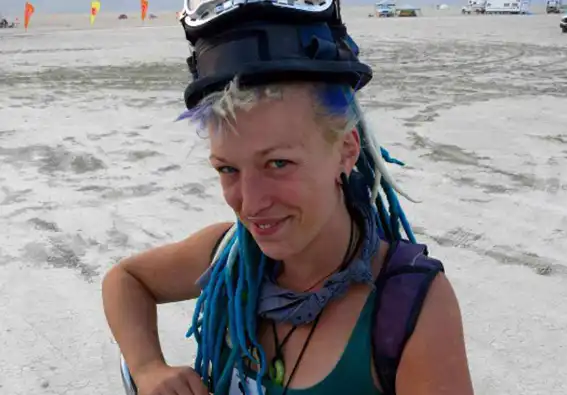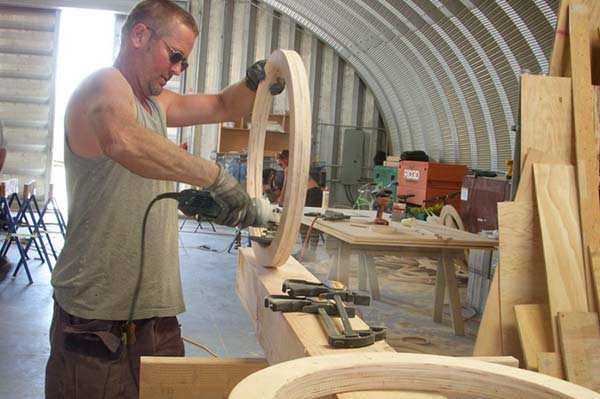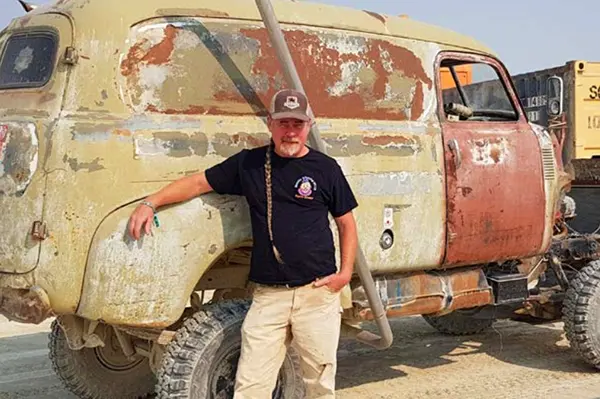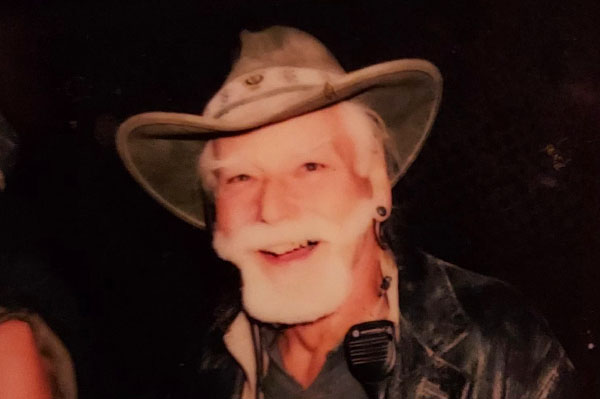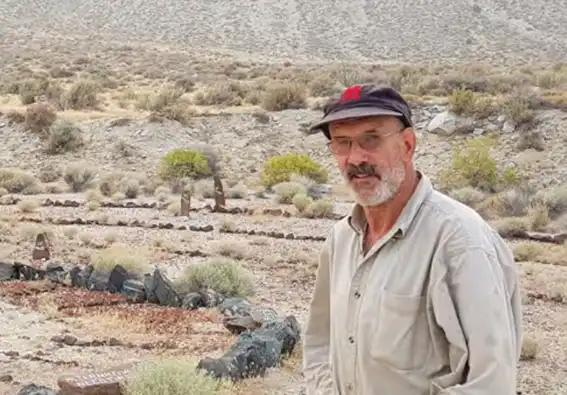
This is a collection of DPW member interviews that I gathered on-site during the 2016, 2017, and 2018 seasons, with a few conducted online in 2021. All interviews were voluntary acts of participation, making this a non-exclusive list of DPW members. Each interviewee featured here gave their consent for their story to be shared online.
DPW members are responsible for building and striking down Black Rock City, where Burning Man takes place annually. This work primarily occurs from mid-July to early October and includes “Playa Restoration,” the meticulous cleaning of the Playa after strike.
My name is Flo—Flore Muguet. While working with the DPW, I was amazed by the unique biographies of each member and the distinct group experiences and histories within each DPW department. The idea for this project grew spontaneously from those encounters. As an anthropologist, it felt natural to collect and highlight the living memory of the DPW, an incredible “backstage” labor force behind Burning Man.
This project is non-profit and has been entirely self-funded (receiving no financial support from Burning Man or any academic institution) through a long and detailed process. This process included recording, transcribing, editing, graphic design, communication, and proofreading to obtain interviewee consent, as well as reworking the text and layout for continuous improvement.
While working full-time as a teacher at an awesome alternative, self-directed public high school in Paris (Lycée Autogéré de Paris) until 2023, I dedicated my free time to this project. In 2020, I also welcomed my son, Anoa. I extend heartfelt thanks to all the participants for their patience and understanding over the years.
Special thanks go to Laurel Teal for her unwavering support throughout this project. Laurel served as the project historian and edited the text versions of the interviews. Her expertise, especially with English editing in the early stages, was instrumental, and I am deeply grateful for her help. I also want to thank Cougar Bait for creating the fantastic website you are now exploring.
To ensure this project is free and accessible to everyone, I present it both as a website and as an interactive PDF available here (soon). The project is published under a Creative Commons license:
DPWSTORYBOOK © 2024 by Flore Muguet is licensed under Creative Commons Attribution-NonCommercial-NoDerivatives 4.0 International.
Visit also neoanthropology.com to see a couple of interviews with artists and actors from the U.S. West Coast transformational festival scene.
In the very beginning of Burning Man
This section features interviews with Larry Harvey, John Law, William Binzen, and Flash Hopkins (to come), though it is far from an exclusive list. Burning Man’s early days were shaped by many contributors and driven by a collaborative community.
Inspired by Mary Grauberger’s solstice celebrations, Larry Harvey, who later became the leader of Burning Man, and Jerry James constructed and burned the first wooden Man on San Francisco’s Baker Beach in 1986.
In 1990, Burning Man joined the Cacophony Society for their “Zone Trip #4,” relocating to Nevada’s Black Rock Desert. The Cacophony Society, with John Law as an active member, was a countercultural network known for its surreal and provocative events. It played a pivotal role in shaping the event’s ethos, bringing radical experimentation to Burning Man.
Desert Siteworks (1992–1994), a nearby project guided by William Binzen, introduced immersive art, rituals, and “intentional community,” influencing the artistic side of Burning Man.
Flash Hopkins, a longtime friend of Larry Harvey and former bike messenger alongside him, was a constant presence, contributing his creative energy during the event’s formative years.
LARRY HARVEY
Larry Harvey (1948–2018) was one of the instrumental figures behind one of the most iconic cultural events of our time, participating in the creation of Burning Man out of a propitious subcultural context. Burning Man began in 1986 as a small gathering on San Francisco’s Baker Beach, inspired by Mary Grauberger’s solstice celebrations. Together with his friend Jerry James, a carpenter, Larry constructed and burned the first wooden effigy, sparking what would grow into an enduring cultural phenomenon. A gardener with a deep passion for philosophy and the human sciences, Larry was known for his ability to engage in profound and thought-provoking conversations.
In 1990, Burning Man joined the Cacophony Society for their “Zone Trip #4,” relocating the event to Nevada’s Black Rock Desert. The Cacophony Society, an experimental movement of anarchic free thinkers, was known for creating absurd, provocative, and participatory experiences that often challenged mainstream norms. Collaborations with key Cacophonists like John Law and Michael Mikel infused Burning Man with a spirit of radical experimentation. A nearby project called Desert Siteworks (1992–1994), led by William Binzen, added further artistic, ritualistic, and “intentional community” dimensions. Over the years, Burning Man evolved into a week-long radical experiment in community, art, and self-expression.
Larry played a pivotal role in formalizing the event’s structure, co-founding Black Rock City LLC in 1999 alongside Marian Goodell, Harley K. DuBois, Crimson Rose, Will Roger Peterson, and Michael Mikel. In 2004, he articulated the 10 Principles of Burning Man, offering a philosophical foundation that continues to guide the community. In 2013, the LLC transitioned into the nonprofit Burning Man Project, with Larry Harvey as a founding board member and Chief Philosophic Officer, while Marian Goodell assumed the role of CEO. Until his passing in 2018, Larry remained deeply involved, shaping the vision of Burning Man. His intellectual legacy endures, inspiring the global Burning Man community.
This interview was conducted by Flo, Flore Muguet, a French anthropologist, on the Playa in 2015. While the very interesting original interview lasted two hours—punctuated by Larry’s characteristic chain-smoking—only Flo’s few questions addressing rituals, spirituality, and community are included here.
JOHN LAW
John Law, co-founder of Burning Man alongside Michael Mikel and Larry Harvey, reflects in this interview, on the event’s origins and his personal involvement. He recalls Burning Man’s humble beginnings on Baker Beach, its transformation into a major event in the Black Rock Desert, and the key influences that shaped its unique culture, particularly the Cacophony Society, where he was a prominent member, and Desert Siteworks, led by William Binzen. Law, who left Burning Man in 1996, offers a critical perspective on the event’s evolution, highlighting the legacy of the Cacophony Society, the often-overlooked contributions of key female figures like Mary Graubarger, Carrie Galbraith, and Vanessa Kuemmerle, and the central role of collaboration and collective creativity in the event’s genesis.
John Law is the co-author, along with Kevin Evans and Carrie Galbraith, of Tales of the San Francisco Cacophony Society, published in 2013. This book chronicles the history, events, and influence of the Cacophony Society, a group renowned for its pranks, social experiments, and countercultural activities.
This interview was conducted by “Flo”, Flore Muguet, a French anthropologist, in March 2024. Most of Flo’s questions have been omitted to improve the reading flow.
John Law carefully edited the text in November 2024.
WILLIAM BINZEN
William Binzen is an American artist and photographer. He directed Desert Siteworks over three years, from 1992 to 1994, a project that took place in the Black Rock Desert, near the location of Burning Man. On his website, williambinzen.com, Desert Siteworks is described as “an experimental, temporary art community,” and it is noted that he was “instrumental in helping make art a major focus of Burning Man.”
This written interview was conducted by “Flo,” Flore Muguet, a French anthropologist, in 2024.
THE COUNCIL OF DARKNESS
This section features Coyote, Cobra Commander, and DA, which is a non-exclusive list of the ever-evolving group known as the DPW Council of Darkness. As there are full-time employees, their interviews were reviewed and approved by the Burning Man Media Team.
The DPW Council of Darkness leads the Department of Public Works (DPW) group. Distinct from the Burning Man Project’s Board of Directors but also composed of full-time Burning Man employees.
The history of the DPW’s development is detailed in the 2016 DPW Handbook written by Logan Mirto/Cobra Commander:
“Since our founding in 1998, Will Roger had managed things. Will and Flynn Mauthe and Coyote. Things were different then. Feral, Ranch-centric times. Those ‘Old Days’ of DPW you may hear folks talking about? That was it. Will stepped down from managing the DPW in 2003, and Flynn left shortly after.”
This transformation gave rise to the DPW Council of Darkness, a leadership collective that replaced singular management. The Council was founded by core members including Coyote, Playground, HazMatt, and Dago Bay, who recognized the need to distribute leadership responsibilities. More individuals evolved or joined, and by 2016 (my first year in DPW), the Council consisted of the following members:
The following descriptions are quoted from the 2016 DPW Handbook:
Chaos: DPW Department Manager
“Manages the department and directly oversees several projects, such as HEaT and Construction.”
Coyote : Black Rock City Superintendent
“Plans and oversees the construction of Black Rock City.”
Cobra Commander: DPW Crewmaster & Labor Manager
“Recruits and organizes the crew, including leading the morning meetings.”
D.A. : Restoration Manager
“Supervises the cleanup efforts and executes the Leave No Trace (LNT) initiative.”
Fireball : Nevada Properties Manager
“Manages Nevada-based workshops, properties, and their teams.”
HazMatt : Business Services Manager
“Deals with logistics, procurement, and vendor coordination.”
COYOTE
Coyote/ Tony Perez spent his early adulthood as a musician on the road for about 15 years. Originally from Michigan, he moved to San Francisco in 1979 and started a music career in 1980. His first Burning Man was ’96. In 97’, he got the first Burning Man laminate by Will Roger and started to seriously pound t-stakes as well as laying out the city itself. In ’98, he became the Site manager of the just created Department of Public Works. He has overseen since then production of the city infrastructure. He was one of the first clean-up crew managers. He is part of DPW council of Darkness from the start. He became a full-time Burning Man employee in 2008. From 1998 to 2008, he would go back to his carpenter job in San Francisco after the DPW season. He lives in San Francisco with his wife Melissa and their twin sons.
Coyote is also a writer and storyteller; he wrote a book Built to Burn: Tales of the Desert Carnies of Burning Man published in 2020. His blogging and podcasts are accessible on his website: https://www. tonycoyoteperez.com/
This interview was conducted by “Flo”, Flore Muguet, a French anthropologist, in 2016. Most of Flo’s questions have been omitted to improve reading flow. Coyote edited the text in 2024.
DA
DA is the Playa Restoration /Environment Manager. His first Burning Man was in 1997. After working on an art project during the event in 2000, he joined the Department of Public Works in 2000 doing the “cleanup crew”. By 2003, he had become the full manager. As his budget increased, he was able to go from 1 to 4-line sweeps, gathering roughly 175 people in 2021. He was a founding member of “Special Forces”, DA was a founding member of the “Special Forces,” a group dedicated to addressing the most challenging cleanup areas: the “hot spots”. In 2006, he invented the Playa Restoration MOOP Map with the concept of the red, yellow, green colors marking the speed progression of the line sweep and therefore the amount of MOOP in each zone. Also in 2006, he created the Talent show as a great finale of Playa Restoration. He studied graphic design and illustration, and he’s done the theme art for Burning Man which has been exhibited at the Smithsonian.
This interview was conducted online by “Flo”, Flore Muguet, a French anthropologist, in 2021. Most of Flo’s questions have been omitted to improve reading flow.
LOGAN
Logan Mirto, also known as “Cobra Commander,” has been a key figure of the Department of Public Works (DPW) at Black Rock City, Nevada, since 1998. Originally from Dallas, Texas, Logan joined the DPW after traveling with a circus troupe that brought him to Burning Man. From 2005 to 2021, he served as the DPW Personnel Manager leading the daily morning meetings, a central routine for the crew. Logan is also known for his notable 2005 art project, the “Dicky Box,” a 10 ft. by 10 ft. plexiglass cube installation. A full time worker for years, Logan “retired” from Burning Man in 2024.
This interview was conducted by “Flo”, Flore Muguet, a French anthropologist, in 2016. Most of Flo’s questions have been omitted to improve reading flow.
A few departments are not represented here, simply because no one volunteered for interviews, or perhaps they weren’t aware of the project, or they work more behind the scenes, and I didn’t have the opportunity to meet them. The focus was on welcoming individuals who wanted to share their stories, rather than seeking volunteers to complete a list of departments. That said, these departments remain an integral part of the DPW. As of the 2018 organizational structure, the following are not included: DPW Depot, Gerlach Estates, Heavy Equipment and Transpo (HEAT), Man Base, Metal Shop, Purchasing and Receiving, Roadworks, Showers, Waterworks, and roles such as DPW Administrative associate, DPW Volunteer Coordinator, Logistics.
Artery CONSTRUCTION
Artery Everywhere is the crew responsible for building the tall, intricate white wooden structures of the Artery Everywhere Pavilion, an art resource center for artists and burners. It facilitates the placement and exhibition of art during Burning Man and provides information about art installations on the Playa.
TPR
Trailer Park Romeo (TPR), whose real name is Nathen, is a key member of the DPW. Originally nicknamed “Ponyboy” for his youthful blond appearance, he is of mixed heritage, with a Jicarilla Apache father and a Scandinavian mother. He joined the DPW in 1999 and served as Tony “Coyote’s” right-hand man for twelve years. With 20 years of surveying experience by 2005, he became the Spires manager, later moving to Transpo within the Heavy Equipment and Transportation (HEAT) team in 2009. In 2016, he took on the role of construction manager for the new Artery Everywhere pavilion.
This interview was conducted by “Flo”, Flore Muguet, a French anthropologist, in 2017. Most of Flo’s questions have been omitted to improve reading flow.
PETER
Peter’s first Burning Man was in 2009, thanks to a ticket gifted by his sister, who was a main organizer of Thunderdome—a well-known camp celebrated for its theatrical play fights under a massive dome, reminiscent of Mad Max. Passionate about active participation, he initially volunteered at Arctica, the ice-selling station at Burning Man, before becoming deeply involved in Thunderdome as a puller. In 2017, at the age of 48, he started his journey with the Department of Public Works (DPW) by joining the Artery Construction Department, a wooden structure that housed information about art installations on the Playa.
This interview was conducted by “Flo”, Flore Muguet, a French anthropologist, in 2017. Most of Flo’s questions have been omitted to improve reading flow.
GUILLAUME
Guillaume is a member of the French Maker and Burner scene. He initiated and co-directed the Villette Makers in Paris for many years. Since 2016, he has been an active member of the DPW, particularly within the Artery department.
This interview was conducted by “Flo”, Flore Muguet, a French anthropologist, in 2016. Most of Flo’s questions have been omitted to improve reading flow.
P.S.: As of 2024, he is distilling absinthe and other liquors somewhere in the Morvan, France.
ARCTICA CONSTRUCTION
The Arctica/Black Ice Construction Crew constructs the three ice distribution stations that serve Burning Man theme camps and participants. These stations are strategically located in key areas of the habitable part of Black Rock City: the 3:00 Keyhole, the Center Camp Ring, and the 9:00 Keyhole, ensuring easy access for all. Until 2018, ice, coffee, and fuel for authorized vehicles were the only items sold at Burning Man. After COVID, coffee sales at Center Camp were discontinued.
FI
Fi was born in Meknès, Morocco, and grew up in France after his father became a pilot for Air France. He initially pursued studies in mathematics and architecture before transitioning to computer science. A sailing enthusiast, he crossed the Atlantic multiple times and worked in diverse fields, ranging from sales at IBM to boat building. After the tragic death of his wife in a horseback riding accident, Fi found a new path at Burning Man, where he became part of the Gerlach community and the DPW. Known for his keen attention to detail and innovative mindset, he has held various roles within the DPW, particularly in construction and project management. He has lived in Gerlach permanently since 2013.
This interview was conducted by “Flo”, Flore Muguet, a French anthropologist, in 2016.
Auto Shop
The DPW Auto Shop handles the mechanical maintenance of the fleet vehicles, ensuring they’re ready to endure the harsh Playa conditions. Their work often extends beyond the usual DPW season, with a pre- and post-season at the Ranch that can span up to six months in total.
ZIGGIE
Ziggie is the assistant manager of the DPW Auto Shop. Each year, he and his team work with the DPW for a six-month period. Named after David Bowie’s iconic character, Ziggie joined the Auto Shop in 2013 during Strike. Since then, he has played a crucial role in managing and customizing the fleet vehicles, contributing to the unique culture of the DPW by ensuring that each vehicle reflects the personality of its crew while remaining fully functional.
This interview was conducted by “Flo”, Flore Muguet, a French anthropologist, in 2018. Most of Flo’s questions have been omitted to improve reading flow.
BIKES
The Bikes department, officially named the BRC Yellow Bike Project (also known as Black Rock Community Transit or BRCT), builds and repairs 1,000 communal bicycles each year. These bikes are designed to be shared and used for free during Burning Man. Despite their name, “Yellow Bikes”—a playful joke—they are actually painted green. The Bikes team is known for their tight-knit culture and their collection of unique and creative freak bikes. A key ritual for the team is the Bologna Hole Blitz on the opening day of Burning Man. In this lively tradition, the Bikes crew, along with other DPW members, rides the Yellow Bikes from the Ranch to the Playa in a joyful, celebratory adventure. During the event, the team also carries out “Re-po” operations, retrieving communal bikes that burners try to hide, decorate, or lock for personal use.
BALLYHOO BETTY
Betty, known as Ballyhoo Betty, is the dedicated manager of the bike program at Burning Man. She began in 2011 as a volunteer under the original, old-school Black Label leadership of the program. With a passion for freak bikes and cycling, a background in circus arts and street performance, and a keen interest in DIY fabrication, Betty has transformed the bike program, expanding the fleet to over 1,000 bikes and fostering a community-oriented approach. During Resto, she also leads ‘metal yoga sessions’ for those who catch the first bus to the playa.
This written interview was conducted by “Flo”, Flore Muguet, a French anthropologist, in 2021. Most of Flo’s questions have been omitted to improve reading flow.
BLACK ROCK SALOON
The Black Rock Saloon is a small house located in the heart of Gerlach, offering several rooms to chill in downtime. It is typically used for pre- and post-Playa living—before Move Day in early August during Build time, and after Strike in mid-September during Playa Restoration.
The main room, often the liveliest, serves as the bar, where drinks are offered after work alongside a pool table. The wooden bar top is uniquely carved with the names of DPW crew members, preserving the memory of the community. Another room is equipped with computers and Wi-Fi, providing a comfortable space to unwind.
The back room doubles as a stage for band performances or the Talent Show, which marks the end of Resto. Additionally, there is a TV room for movie nights and a laundry area for practical needs. The saloon also serves as a storage hub for food and drink donations collected from burners during Collexodus.
With the comfort of a solid house and its welcoming atmosphere, the Black Rock Saloon is a safe place where one can chill, recharge, escape the dust, and enjoy quality time with friends over nice drinks.
MISS ROACH & SAILOR
Miss Roach and Sailor, dedicated managers of the Black Rock Saloon in Gerlach, play an essential role in the off-Playa social life of the Department of Public Works (DPW) during the pre-build and Resto periods. Alcohol at the Saloon is sourced through donations from the annual Collexodus. With years of experience in both the DPW and Gate departments, they have transformed the Saloon into more than just a bar; it has become a communal living room—a place for camaraderie, support, and unwinding after long days, where everyone feels safe and valued. It’s a place where community belonging is shown. Within the main bar room, specific shelves adorned with photos commemorate members who have passed on. The wooden bar counter, where members proudly etch their names, marks each person’s unique contribution to this close-knit community.
This interview was conducted in the Saloon by “Flo”, Flore Muguet, a French anthropologist, in 2016. Most of Flo’s questions have been omitted to improve reading flow.
BLM COMPOUND
The BLM Compound, located just outside the Black Rock City fence, serves as a base for federal employees, including law enforcement officers, a small jail, and Bureau of Land Management staff with dedicated radio dispatch. It functions as the operational headquarters for overseeing the Black Rock Desert and ensuring compliance with regulations during the Burning Man event. For most burners, the compound goes largely unnoticed.
The site includes a commissary for meals, a dedicated waste sorting and managing station (TSA), and porta-potties exclusively for their use. The legend says that it even includes an ice-snow cone dispenser.
The DPW crew manages the construction and maintenance of the BLM Compound. This includes building the fence, setting up algecos, installing lights and generators, furnishing the spaces with foldable plastic chairs and tables, and ensuring ongoing upkeep throughout the event. The manager who is the BLM project manager for Burning Man, oversees contracts and coordinates federal agencies with the event.
SWEET RIDE
Sweet Ride, is the Bureau of Land Management (BLM) project manager for Burning Man. As the liaison between the federal government and Burning Man, Sweet Ride manages contracts and oversees the Joint Operation Center (JOC), ensuring smooth collaboration between BLM, Black Rock City (BRC), Emergency Services Dispatch (ESD), and Pershing County law enforcement.
This partial interview was conducted by “Flo”, Flore Muguet, a French anthropologist, in 2016 and edited by Sweet Ride in 2023. Most of Flo’s questions have been omitted to improve reading flow.
Center Camp Construction/ Oculus
Oculus is the DPW crew responsible for building Center Camp, a canopy structure providing a circular acre of shade that serves as the workspace for the Center Camp Burning Man teams. This highly complex structure requires the expertise of riggers, carpenters, and scissor lift equipment operators. Before COVID, Center Camp offered coffee for sale. Post-COVID, it continues to serve as a central gathering place at the heart of the city, featuring carpeted floors where burners can still chill, enjoy art, participate in talks, practice acro-yoga, and more.
AUSTINTATIOUS
Austin became the DPW Oculus manager in 2019, overseeing the construction of Center Camp Café. She first joined the DPW in 2006 for Playa Restoration, following an intense and life-changing period from 2005 to 2006. This journey began with her involvement in Burners Without Borders’ Hurricane Katrina relief operations and concluded with a season as a ski patroller and rafting guide during a record-breaking, deadly year.
She has always enjoyed her role with the Oculus, appreciating the range of skills required to build Center Camp and the collaboration with various crews and departments that contribute to its vibrant atmosphere. Since the COVID pandemic, BMOrg has chosen to discontinue coffee service, and Center Camp is now exploring new ways to reestablish itself as a dynamic heart of Black Rock City.
This interview was conducted by “Flo”, Flore Muguet, a French anthropologist, in 2018 and edited to its final version by Austin in 2024. Most of Flo’s questions have been omitted to improve reading flow.
COMMISSARY
The Commissary crew is responsible for constructing the gigantic tent and maintaining it against the high winds of the Playa. The Commissary provides three hot meals daily to the DPW during the Build and Strike phases of the on-Playa season. During the event, access is limited to authorized DPW, Burning Man staff, and volunteers. Meal times are as follows: breakfast from 6 to 8:30 AM, lunch from 11 AM to 2 PM, and dinner from 5 to 8 PM. Luckily, for those late-night cravings, ‘Cereal Camp’ remains accessible after hours.
Everyone must pass through the handwashing station tunnel before entering. Food and drinks are prepared by Spectrum company in giant trucks stationed next to the Commissary. The Commissary team ensures that DPW laminates are scanned, works in collaboration with Spectrum, and keeps the space welcoming and clean. Additionally, the dedicated TSA team helps guests sort their trash, ensuring waste can be later properly placed into designated dumpsters.
At the end of Strike, the fancy dress-up ritual known as the ‘Last Supper’ is held as a final communal meal before the tent is dismantled. Separately, the Shade crew has its own ritual, dining atop a shade structure in front of the Commissary, adding a unique and playful note towards the end of the season.
SYLKIA
Sylkia is the Gerlach and on-playa Commissary manager at Burning Man. Her first Burn was in 2006, a surprise organized by her friend Dave during a backpacking trip from Los Angeles to Toronto. In 2008, she began working with the DPW as a cook at the Ranch. Over the years, she transitioned to the role of Resto cook and eventually became the Commissary manager. Her typical workday involves managing breakfast from 6 to 8:30 AM, lunch from 11 AM to 2 PM, and dinner from 5 to 8 PM.
This interview was conducted by “Flo”, Flore Muguet, a French anthropologist, in 2016. Most of Flo’s questions have been omitted to improve reading flow.
DART
Dart! joined the DPW in 2015. He manages the Commissary tent and has prevented it from blowing away many times. Born in Memphis and currently residing in Austin, Texas, Dart! works in festival production, specializing in creating artistic installations using metal, fiberglass, wood, and plastic. After leaving the Navy and working in home remodeling, he discovered Burner culture and attended his first Burning Man in 2011.
This interview was conducted by “Flo”, Flore Muguet, a French anthropologist, in 2017. Most of Flo’s questions have been omitted to improve reading flow.
DISPATCH
The Dispatch bureau is located at the Depot, at the very end of 5:30, where the iconic daily DPW morning meeting takes place. Dispatch operates 24/7, constantly monitoring all radio traffic on the DPW channel and other event ops channels. They can re-direct a request if needed. They’re likely always on top of things, as some people use a different radio handle from their Playa name or switch it up every year.
SUMMER
Summer Burkes has been an active figure in San Francisco’s counterculture and alternative scenes since the late 1990s. She joined the Cacophony Society and Cyclecide in 1996 and has been part of Burning Man’s Department of Public Works (DPW) since 1998, including roles with DPW Dispatch. A dedicated writer and journalist, she has contributed to the San Francisco Bay Guardian and writes for the Burning Man Journal.
This interview was conducted by “Flo”, Flore Muguet, a French anthropologist, in 2016. Most of Flo’s questions have been omitted to improve reading flow. Summer carefully edited the text.
HAPPY MAX
Christopher, known affectionately as Happy Max, hails from Richmond, Virginia. His first regional burn was in 2014, and he joined Burning Man’s DPW in 2015. While battling an aggressive form of cancer, Max has contributed significantly to the DPW, working in Dispatch and TSA.
This interview was conducted by “Flo”, Flore Muguet, a French anthropologist, in 2018. Most of Flo’s questions have been omitted to improve reading flow.
FENCE CREW
The Fence crew leads Fence Day, a ritual where all present DPW members work together to pound the 9.2 miles of perimeter fence around Black Rock City in a single day, early in August at the start of the season. Two teams are formed: one, called the Dawn Patrol, starts early to handle T-stake pounding, while the other, with a later start, ties three strings at different levels on the T-stakes, rolls out the fence, and attaches it to the strings. Once the T-stake team finishes, they assist Team Strings. Beyond this impressive day, the Fence crew is also responsible for pounding and maintaining other fences across the Playa throughout the season. It’s a tough and loud job, historically managed by Just George, known for his military push-ups, and the iconic Cowboy Carl in 2018.
HOWLER
Howler is a member of the DPW Fence crew, which sets up and maintains the perimeters and boundaries of Black Rock City. He has been attending Burning Man since 2003 and began working for ESD in 2013. In 2015, he met Just George and Cowboy Carl, the DPW Fence managers, who brought him into the crew. Howler is dedicated to pounding T-stakes and setting up fences. He starts his days early with a workout in the Ghetto, using the gym equipment he brings to the playa every year, followed by lectures. Although not very social, he enjoys the energy of others and moments of laughter, like the 4:20 Spire.
This written ‘chat’ interview was conducted online by “Flo”, Flore Muguet, a French anthropologist, in 2021. Most of Flo’s questions have been omitted to improve reading flow.
FIRST CAMP CONSTRUCTION
The First Camp Construction Crew builds the camp’s wooden blue infrastructure with carpeted floors, where Burning Man founders, including Larry Harvey, and many employees of the Burning Man Organization, including CEO Marian Goodell, live on the Playa. The camp is located near the Esplanade. The DPW First Camp crew hosts the best Hip-Hop party during the DPW build season. During the event, the camp offers showers and food service specifically for its members. The Burning Man Organization hosts, among other business and media-related activities, the ‘Collaborators Cocktail Party’ at First Camp during the event. This invitation-only party is for Regional Contacts, leaders from the worldwide Burning Man community, official Regional events, and influential artists and mécènes of the year.
STARCHILD
Starchild, whose real name is Matthew, grew up in Sterling Heights, a suburb of Detroit. He attended his first Burning Man in 2005 and camped with The Black Rock Burner Hostel. Soon after, he left his home and car to join Burners Without Borders as a carpenter, helping with Katrina relief alongside other DPW members. By 2006, he was working with the DPW and joined Burning Man’s Black Rock Solar program in 2008. Starchild has managed the construction of First Camp for many years—where Burning Man’s co-founders and some staff camp on the playa—leading a team of 10. He’s known for his love of hip-hop culture and for throwing great parties. He even added a basketball hoop to his car.
This interview was conducted by “Flo”, Flore Muguet, a French anthropologist, in 2016. Most of Flo’s questions have been omitted to improve reading flow.
FLUFFERS
These very hard workers, who carry water in igloos and often have cracked hands from constant exposure to water, definitely have nothing to do with any adult-rated movie backstage. However, it’s a fitting metaphor to say they keep all DPW workers up and running. They navigate the Playa with their trucks, going to the teams to offer water, snacks, and, during Playa Restoration, a delightful shade as they park. They re-load the water at the Black Rock Saloon. The presence of Fluffers, along with strict hygiene rules—such as carefully washing the igloos and avoiding contact with the spouts—has greatly improved DPW health. As a result, water has become less of a risk than PBR, and Monkeypox is now definitely part of the DPW’s old days.
NIPPS
Nipps Williams, affectionately known as ‘Mama Nipps,’ has been a dedicated participant of Burning Man since 2000 and an active member of the DPW since 2004. Renowned for her compassion and commitment, Nipps has excelled as a ‘fluffer’ on the playa. Her care for others led her to establish and lead the Fluffers department, which supports the DPW crews with water, snacks, and essential needs. Under her guidance, the department has grown significantly, starting with just one vehicle and expanding to six by her tenth year, reflecting the increasing importance and recognition of the support they provide to the crews.
This interview was conducted by “Flo,” Flore Muguet, a French anthropologist, in 2016. Most of Flo’s questions have been omitted to improve reading flow. P.S.: She had a wonderful daughter named Hazel in 2017 with Flip, also a DPW member. They all live year-round in Gerlach, Nevada.
FUEL
The Fuel Department, also known as PETROL, is essential for powering Black Rock City with liquid fuels and propane. It ensures reliable fuel delivery to infrastructure, theme camps, mutant vehicles, and art projects, while also supporting off-playa locations such as Gerlach, Fly Ranch, and Black Rock Station Ranch.
As of 2016, the department operated on a massive scale, managing up to 10,000 gallons of fuel daily during the event. This was accomplished with four fuel trucks and two propane trucks, efficiently distributing fuel through two primary channels on the Playa: direct delivery to field sites and dispensing at fueling stations, including the Staff PETROL Depot on 5:30 Road and the HELL Station at 10:00 & L. Supplies are transported from pipelines to Reno, through Sparks, and then to the Playa, where the team coordinates unloading, tracking, and ensuring all equipment and generators remain fueled and operational.
COACH
Coach, hailing from Eugene, Oregon, has been a committed mechanic with the Department of Public Works since 2014. Alongside his work as a bartender and server, he’s developed deep skills in both construction and mechanics. Beginning as a fuel attendant, Coach quickly moved up to become the lead mechanic of the fuel team. A dedicated musician, he finds real peace in playing drums with his band.
This interview was conducted in 2018 by “Flo”, Flore Muguet a French anthropologist. Most of Flo’s questions have been omitted to improve reading flow.
RAILROAD MIKE
Railroad Mike attended his first Burning Man in 2002. With a background in the railroad industry, he quickly became the Transportation manager after his first DPW season. Known for his dedication and problem-solving skills, he later transitioned to the role of Fuel Master, where he managed and optimized fuel distribution—a critical component of the event’s logistics.
This interview was conducted by “Flo”, Flore Muguet, a French anthropologist, in 2016. Most of Flo’s questions have been omitted to improve reading flow.
GHETTO
The DPW Ghetto is the main official camp for the Department of Public Works (DPW) on the Playa. It serves as the primary living space for DPW members, offering essential amenities such as shade pods, electricity, port-o-potties, and burn barrels. The Ghetto is meticulously organized to accommodate the large DPW crew. This includes mapping the entire block, organizing shade pods for different teams, navigating interpersonal dynamics to maintain a functional and welcoming environment, and installing camp infrastructure such as the Ghetto Bar deck. Known for hosting great parties, the Ghetto Bar is a lively gathering spot for DPW members and friends. It reflects the DPW motto: “Work Hard, Party Hard,” offering a chill and safe space to hang out after the intense labor of building and maintaining Black Rock City.
JUICY JAKE
Juicy Jake attended his first burn at the San Diego Regional Decompression in 2009. His first Burning Man was in 2010, and he joined the DPW in 2011. Since 2013, he has been an integral part of the Ghetto crew, the camp where most DPW members stay on the playa. He became the manager in 2016, known for his hands-on approach and strong interpersonal skills. Juicy Jake has played a crucial role in organizing and managing the logistics of the Ghetto, ensuring a comfortable and safe space for all members.
This interview was conducted by “Flo”, Flore Muguet, a French anthropologist, in 2016. Most of Flo’s questions have been omitted to improve reading flow.
golf carts
The Golf Carts Department is located near the Commissary on the Playa. As of 2018, they have managed a fleet of 100 golf carts used by authorized personnel to navigate Burning Man. This dedicated crew of 15 works tirelessly for 22 days to ensure all vehicles remain operational and ready to support the various departments of Black Rock City. The team handles daily maintenance, on-the-spot repairs, and even assists with art cars and other vehicles when needed, being the real magic behind the burner motto “Playa Provides.” Their meticulous servicing process includes a valet key system and a detailed checklist for each cart, ensuring smooth operations throughout the event. True to their fun and welcoming attitude, the Golf Carts Department also runs a bar affectionately called the “Wrong Hole,” located close to the DPW Ghetto Bar and the Gate’s Black Hole bar.
HIGHWAY CLEANUP
The Highway Cleanup Crew ensures that, post-event, the roads around Black Rock City are cleared of MOOP (Matter Out Of Place) left by departing Burning Man vehicles, helping maintain good relations with local communities affected by the event.
As of 2016, the crew operates with three trucks and 12 members, equipped with gloves, moop sticks, and high-visibility jackets to safely collect debris ranging from mattresses to biological waste. Working alongside speeding semi-trucks and other traffic, their work is vital to Nevada’s cleanup efforts.
Year-round, volunteers from groups like Friends of Black Rock and Stewards of the Black Rock Desert also contribute to preserving the Nevada landscape through ongoing cleanup initiatives.
SANSA
Sansa Asylum is a multifaceted performer and clairvoyant who first attended Burning Man in 1997 after her father filmed a documentary about the event in 1996. Renowned for her vibrant stage presence and psychic abilities, she also plays a key role at the event, leading the Department of Public Works (DPW) Highway Cleanup Crew. This team is responsible for collecting trash along the roads surrounding the Burning Man site during Playa Restoration, dealing with debris that may have been discarded intentionally or unintentionally, including items like mattresses or other objects blown off vehicles.
This interview was conducted by “Flo”, Flore Muguet, a French anthropologist, in 2016. Most of Flo’s questions have been omitted to improve reading flow.
DACE
Dace attended his first Burning Man in 1997 and began his involvement with the DPW in 2003, starting with Highway Cleanup. In 2004, he joined the Shade Crew under the leadership of his friend Quiet Earp. The Shade Crew is responsible for building all the shade structures for Burning Man workers and public infrastructure. Dace’s experiences at Burning Man have been transformative, profoundly shaping his personal growth and sense of community.
This interview was conducted by “Flo”, Flore Muguet, a French anthropologist, in 2016. Flo’s questions have been omitted to improve reading flow.
HOUSING
The Housing Department became an official department in 2010. By 2017, it managed 800 different types of living units used by Burning Man’s staff, including 190 trailers—123 owned by Burning Man and the rest designated as management personal support trailers—112 boxes, a similar number of LC Living Containers, and support for office boxes.
This department plays a crucial role in supporting both organizationally owned trailers and those brought by managers and staff. Its responsibilities range from transporting units between Gerlach, the Ranch, and the Playa, to addressing maintenance issues such as leaks and power outages. The team logs hundreds of calls daily, tackling diverse tasks such as relocating housing units for shade or repairing non-functional amenities. The dynamic and unpredictable environment keeps the crew engaged, ensuring no two days are alike as they adapt to the unique challenges of managing Burning Man’s staff accommodations.
MAKE-OUT QUEEN
Make-Out Queen first attended Burning Man in 2002. Initially skeptical about the event, she quickly grew to like it and started volunteering at the Center Camp Café. Her playful spirit earned her the nickname ‘Make-Out Queen’ after a memorable ‘Make-Out Monday’ contest. By 2011, she became the Housing Manager, overseeing 123 trailers, 112 boxes, and various living containers (LC) used by Burning Man’s staff. Known for her hands-on style, she has been a key figure in the DPW community. Even before joining the DPW, she started MCing at the Death Guild Thunderdome, a Mad Max-style playfight dome. Her performances, especially during the DPW-loved ‘Friends and Family Night,’ remain a big hit.
This interview was conducted by “Flo”, Flore Muguet, a French anthropologist, in 2018. Most of Flo’s questions have been omitted to improve reading flow.
Nevada Properties: The Ranch,
Container Build, and Rehab
The Nevada Properties department oversees Burning Man’s key sites in Gerlach, including The Ranch (Black Rock Station), the Black Rock Saloon, the Showers Property, the Trailer Park, and the Gerlach Office. These properties support the event’s year-round operations.
The Ranch serves as the primary site for storing, maintaining, and renovating Burning Man’s infrastructure, habitats, and vehicles. Workers at The Ranch, including those on multi-month contracts, engage in year-round efforts to improve and maintain production facilities. The team manages properties, moves containers, operates heavy equipment, and supports various projects, including water system upgrades.
A dedicated crew at The Ranch focuses on Container Build and Rehab, constructing custom wooden structures for offices and housing, such as facilities for Fuel, the Airport, and Arctica, as well as a shower house for First Camp. This demanding work requires precision, teamwork, and adaptability in a harsh, isolated environment.
DISCO
Disco has been involved with the Ranch since 2014 and served as assistant manager from 2016 to 2019, playing a key role in improving its operations and infrastructure. Located near Gerlach, Nevada, the Ranch is Burning Man’s main site for the storage, maintenance, and renovation of the event’s infrastructure, habitats, and vehicles. Some workers hold multi-month contracts to support these extensive year-round efforts.
Previously, he volunteered with Burning Man’s Lamplighters from 2002 to 2008 and also managed the Blue Oasis Theme Camp. Since 2021, Disco has been the facility manager at the Generator in Reno, a creative and collaborative space. With his extensive experience and leadership, he continues to make significant contributions to the Burning Man community, fostering artistic projects and supporting local initiatives.
This interview was conducted by “Flo”, Flore Muguet, a French anthropologist, in 2018. Flo’s questions have been omitted to improve reading flow.
ROXY & GILLES
Roxy: Roxy first attended Burning Man in 2005. She officially joined the workforce in 2012, initially with the Gate team before transitioning to the Department of Public Works (DPW) in 2014. By 2016, she became the manager of the BRC Storage Program, overseeing the logistics of transporting and placing containers for both domestic and international camps.
Giless: With a construction background, Giless joined the DPW at the Ranch in 2016 as the Container Build Manager. He was responsible for building essential facilities and housing for various departments. His first year marked a significant shift, moving from traditional shipping containers to custom wooden structures, enhancing both utility and design.
This interview was conducted by “Flo”, Flore Muguet, a French anthropologist, in Paris in 2016. Flo’s questions have been omitted to improve reading flow.
Placement/BRC Storage Program
The DPW Placement/BRC Storage Program crew navigates the Playa during the DPW Build season with maps detailing the specific container locations provided in advance by Burning Man Theme Camps. They mark the designated spots on the Playa with plastic flags to indicate where the 20-foot containers will be placed. These containers, usually filled with essential camp infrastructure and art, are stored year-round at the Ranch by some returning Theme Camps. Trucks transport them to the flagged locations, ensuring efficient local storage while minimizing environmental impact.
DAHLIA
Dahlia grew up in Pershing County, Nevada, and first experienced Burning Man as a participant before joining the DPW team. Her journey with the DPW began when Hamburgler introduced her to the community, and she quickly found her place with the BRC Storage Crew. Dahlia’s role involves dealing with the on-site placement of storage containers for Theme camps. The supportive and uplifting environment of the DPW gives her a deep sense of belonging and purpose, motivating her to return each year to help build what she calls “the best city in the world.”
This interview was conducted by “Flo”, Flore Muguet, a French anthropologist, in 2016. Flo’s questions have been omitted to improve reading flow.
ROXY & GILLES
Roxy: Roxy first attended Burning Man in 2005. She officially joined the workforce in 2012, initially with the Gate team before transitioning to the Department of Public Works (DPW) in 2014. By 2016, she became the manager of the BRC Storage Program, overseeing the logistics of transporting and placing containers for both domestic and international camps.
Giless: With a construction background, Giless joined the DPW at the Ranch in 2016 as the Container Build Manager. He was responsible for building essential facilities and housing for various departments. His first year marked a significant shift, moving from traditional shipping containers to custom wooden structures, enhancing both utility and design.
This interview was conducted by “Flo”, Flore Muguet, a French anthropologist, in Paris in 2016. Flo’s questions have been omitted to improve reading flow.
plumbing
The Plumbing Department, part of the DPW, ensures that Black Rock City’s water infrastructure operates seamlessly in the harsh desert environment. Responsible for the installation, maintenance, and removal of potable and gray water systems, they support essential areas such as the Commissary, where food is prepared and cleaned, the Fluffers, who supply water to workers, the Wet Spot, which offers showers for workers, and Burning Man organizational camps like First Camp, home to the founders, and the Fire Enclave. They also provide water support for the Rangers and Gate.
Essentially, the Plumbing Department ensures that all non-theme and non-private camps have the necessary water systems to function efficiently during the event. Their work includes managing tanks, pumps, pipes, and hoses, while adhering to Nevada’s strict sanitation regulations. Known for their camaraderie and unique spirit, the team operates heavy vehicles, tackles challenges with expertise, and enjoys moments of fun, such as using a water cannon at the main DPW ritual 4:20 Spire, participating in the Yellow Bike ride called the Bologna Hole Blitz, and the Kickball Party. As one of the first groups to arrive and the last to leave, the Plumbing Department is indispensable to Burning Man’s operations.
RED BEARD
Red Beard, a plumbing enthusiast and water chemistry expert, attended his first burn in 1999. After serving in the Navy, he began returning to the Playa annually in 2008, spending some years as a member of the theme camp Lost Pengouins. In 2015, he joined the DPW’s Plumbing Department.
This interview was conducted by “Flo”, Flore Muguet, a French anthropologist, in 2018. Most of Flo’s questions have been omitted to improve reading flow.
BUCKHORN
Known for his hard work and supportive nature, Dale “Buckhorn” has been with the DPW since 2014. A contractor by trade, Dale is responsible for building the plumbing infrastructure of Black Rock City. His journey with DPW began after a life-changing accident that led him to seek a new direction. In 2016, he brought his two sons to join him at Burning Man.
This interview was conducted by “Flo”, Flore Muguet, a French anthropologist, in 2016. Most of Flo’s questions have been omitted to improve reading flow.
POWER
The Power Department, part of the DPW, is responsible for installing and managing the electrical infrastructure that powers Black Rock City. This essential team ensures electricity flows to critical sectors, including the Man base, the quadrants around Center Camp, the 9:00 and 3:00 keyholes, the Commissary, the Airport, fire stations, ESD stations, Ranger stations, Gate, Greeters, Census, Café Village, Lamplighters, Artery, and Arctica. They also provide power to DPW departments such as the Metal Shop, Bikes, Heavy Equipment Yard, Power Yard, Plumbing Yard, Special Projects, Utilities Village, the Ghetto, and more. From lighting the Man to powering crucial Burning Man staff camps, their work underpins the functioning of the event’s core services, making their reach extensive and indispensable. As of 2018, the team consisted of 7 technicians and 4 volunteers who worked tirelessly to build and maintain the power grids servicing Black Rock City. Deploying over thirty miles of heavy electrical cable and operating large rented generators, their efforts required precise planning, grid visualization, and physically demanding tasks such as carying the rubber-jacketed cables and sometimes manually digging trenches to secure cables. The Power Department’s work is vital to ensuring that essential services and camps have reliable electricity throughout the event.
LEEWAY
Leeway, a longtime Ranger and DPW member, has been a cornerstone of the Burning Man community since 2009. Starting as an electrician, he quickly advanced to become the Power Manager from 2016 to 2021, where he led a team of technicians and volunteers to build and maintain the city’s essential power grids. In March 2022, he transitioned to the role of DPW Personnel Manager.
This interview was conducted by “Flo”, Flore Muguet, a French anthropologist, in 2018. Most of Flo’s questions have been omitted to improve reading flow.
rouStabouts
The Roustabouts are versatile, non-department-specific DPW members, often first-year volunteers, who check in daily with the DPW labor manager or assistant at the Morning Meeting at the Depot. They are assigned to departments needing extra hands for general tasks, supporting dedicated teams during the Build and Strike period. Many eventually settle into specific teams during the season, gaining steady roles and deeper social connections. Others, like me (Flo), enjoy the variety and choose to remain Roustabouts for multiple seasons. This approach offers a unique perspective on the overall process of building Black Rock City, as it allows individuals to experience different departments and tasks, gaining a broader understanding of the city’s construction and strike.
Roustabouts are essential to DPW’s adaptability, providing flexible labor while fostering teamwork and collaboration.
ALLISON
Allison is an experienced commercial construction worker from Maryland and self described “nerd.”In 2016, she attended Burning Man for the first time and worked with DPW during the restoration season. Passionate about the environment and maps, she was drawn to the event’s cleanup and restoration process, which she had read about in an article on geographic information system software.
This interview was conducted in 2016 by “Flo”, Flore Muguet a French anthropologist. Most of Flo’s questions have been omitted to improve reading flow.
TIF
Tif started in the psytrance scene in France in 2010 and later explored ‘transformational festivals’ across Europe while traveling backpacker-style. Along the way, he met burners, which led him to attend his first Burning Man in 2015. He returned in 2016, participating in ‘Highway Cleanup’ and ‘Playa Restoration’ with the DPW. He also attends Nowhere in Spain, one of the largest regional burns in Europe. Tif is an agroecology engineer.
This interview was conducted in French by “Flo”, Flore Muguet, a French anthropologist, in 2016. Most of Flo’s questions have been omitted to improve reading flow.
MARCUS
Marcus is from Sweden and experienced his first Burning Man and DPW in 2016. He was assigned to the Man Base crew as a Roustabout. His journey to Burning Man began unexpectedly when he met a girl on a bus in Los Angeles who talked to him about the event. Marcus found the experience to be both rewarding and unique, highlighting the stark cultural differences between Sweden and the United States.
This interview was conducted by “Flo”, Flore Muguet, a French anthropologist, in 2016. Most of Flo’s questions have been omitted to improve reading flow.
shade
The Shade Department is a vital and dynamic crew responsible for constructing over 100 shade structures totaling more than 3 acres each DPW season. These structures provide essential shade for collective key areas of Burning Man and various working departments, enabling them to operate safely under the intense desert sun.
The Shade crew exemplifies hard work, camaraderie, and adaptability. Their day begins at 07:00 before most crews start so they can take advantage of the cool mornings. While the job doesn’t require much experience, building these structures requires the builders to be good with their hands, the ability to learn quickly, think in their feet, effective team communication, and serious endurance to keep pace with the team which hits the ground running on day one of build. Despite the repetitive nature of tasks like laying out lumber, framing walls, and attaching shade cloths, the team injects fun and shenanigans into their work, fostering a strong sense of community and shared purpose.
Shade department is more than just its three hardworking build teams. Shade has a Survey team that works with incredible precision to lay out the location for the more than 3000 4×4 posts required to build the structures. A Shade Dispatch team keeps communication flowing, while the Shade Quartermaster team ensures all tools and materials are organized, in working order, and ready to send out on the rigs. Each team functions like a limb of the Shade body, vitally important to its operation.
Known for their unique culture of humor and traditions, the Shade crew participates in events like the “Shanquet” (a banquet atop the commissary shade) and the theatrical 4:20 Spire. In this event, Shade plays a central role as each crew within DPW contributes to a lively spectacle, while Shade humorously sets up a “janky” shade structure amid a chaotic, celebratory party. The culture of Shade is critical to its mission. [Thanks Irie for the edits]
FIERYIRIE
Fieryirie joined the DPW in 2008 at the age of 24, while on an impressive bike tour covering 80 to 100 miles per day. That year, she worked as a volunteer Roustabout, assisting various crews, including Shade. After a personal battle with skin cancer, she returned to the playa in 2009 with Burning Man’s Temple Crew. In 2010, she joined back the DPW with Fistica crew, followed by a role as a Fluffer from 2011 to 2015. Her involvement with the Shade Crew began in 2016. In 2017, an injury led her to take on the role of dispatcher. By 2018, she became the manager of the Shade Crew, known for its vibrant culture of hard work, humor, and camaraderie. In addition to her leadership, Fieryirie is recognized for creating Shade patches and the iconic 4” and 11” DPW emblem patches. Irie’s journey is a testament to resilience, adaptability, and a deep commitment to the DPW.
This interview was conducted by “Flo”, Flore Muguet, a French anthropologist, in 2018. Flo’s questions have been omitted to improve reading flow.
LODOG
LoDog is a self-taught carpenter who has been part of the DPW since 2001. As one of the managers on the Shade Crew, he has played a key role in developing and refining the survey and construction techniques used to build shade structures in the harsh desert environment. LoDog seamlessly combines his technical expertise with practical, hands-on skills to guide the team effectively. Thanks to these improvements, the Shade Crew has evolved into one of the most efficient DPW teams at Burning Man.
This interview was conducted by “Flo”, Flore Muguet, a French anthropologist, in 2017. Flo’s questions have been omitted to improve reading flow.
VOTED BEST DAVE
Voted Best Dave first attended Burning Man in 2003 with a group of friends, bringing along a skateboard half-pipe. Over the next few years, their group evolved into a theme camp called “Voted Best Camp.” When he joined the Department of Public Works (DPW) in 2010, he was given the nickname “Voted Best Dave” as a nod to his camp. He served as a lead on the Shade Crew until 2017. Outside of Burning Man, he plays drums and sings for the band Vampirates.
This interview was conducted by “Flo”, Flore Muguet, a French anthropologist, in 2016. Flo’s questions have been omitted to improve reading flow.
BISHOP
Bishop attended his first Burning Man and joined the Department of Public Works (DPW) in 2017. Originally from Philadelphia, he spent several years living in the backcountry of Georgia. With a background as a pyro-technician, Bishop also sells body jewelry and indigenous art.
His introduction to the DPW team is one of the most unexpected and fun hiring stories. During the DPW Parade, Bishop responded to a sign handed to him by some DPW women and decided to follow the parade. His humor and laid-back attitude instantly won over the team.
This interview was conducted by “Flo”, Flore Muguet, a French anthropologist, in 2017. Flo’s questions have been omitted to improve reading flow.
sign shop
The DPW Sign Shop creates over 1,000 signs annually to guide and inform participants across Black Rock City, ranging from safety and directional signs to thematic street markers aligned with Burning Man’s annual theme, chosen by Larry Harvey. For example, in 2017’s “Radical Ritual,” street names included “Awe,” “Breath,” and “Ceremony.” These signs are so visually appealing that they’re often stolen quickly—luckily, plastic location markers (like 4&D) remain fixed on T-stakes to ensure navigation. The team also designs iconic Gate Road quotes, inspired by traditional roadside signage, offering reflections tied to the event’s theme.
Operating from the Ranch before the Golden Spike ceremony—the official start of the DPW season—they produce essential infrastructure signage for departments like Gate and Center Camp, with messages such as “don’t die,” “don’t turn here,” and “don’t blow us up.”
As of 2018, they’ve used a Graftech machine for production but aspire to include more hand-painted designs in the future. They also create fun stickers to add a playful touch to their work.
BULLWINKL
Bullwinkl has been with the DPW since 2013. A former Marine, artist, Cherokee citizen, and schoolteacher, he brings a unique blend of skills and experience to his role as the Sign Shop Manager, creating informative and signaletic signs for Black Rock City. His journey from combat illustrator in the Marines to designing signage with his DPW team underscores his commitment to art, education, and community. He earned a master’s degree in Science and Art Education in 2020.
This interview was conducted by “Flo”, Flore Muguet, a French anthropologist in 2017. Most of Flo’s questions have been omitted to improve reading flow.
SPECIAL PROJECTS
The Special Projects Department is celebrated for its versatility, adaptability, and wide-ranging responsibilities. Supporting every DPW (Department of Public Works) team’s special carpentry needs, they tackle tasks that often fall between the cracks of other departments. Starting early at the Ranch with specialty construction, the team transitions to the Playa to build and install vertical shade panels, information kiosks, bike racks, access ramps, staircases, solar lights, desks, and the iconic annually renewed Burning Man entrance sign.
On the Playa, the team roams the city, addressing unique carpentry challenges and solving problems on the fly. Renowned for their resourcefulness and willingness to assist, Special Projects is the go-to team for specialized and unconventional tasks. Unlike other departments, they don’t follow a daily routine. They are also known for their creative early burn projects, a cherished DPW ritual marking the end of the exclusive Build phase and the transition to “build week,” when artists and Theme Camps begin their setups. Their distinctive crew vehicle further adds to their character.
The small crew lives in Utilities Village, alongside Plumbers and other teams, setting them apart from the main DPW camp, the Ghetto.
BAR-FIGHT
Bar-fight joined the Special Projects team in 2009 and now manages the department. Special Projects handles specialized carpentry work across the Playa, like building ramps, staircases, bike racks, and putting up signs. Before joining the DPW, Bar-fight spent years exploring caves in Alabama. He was introduced to the DPW and Burning Man by a fellow caver and longtime DPW member named Alabama, who gave him the nickname “Bar-fight,” which led to some initial misunderstandings. Bar-fight quickly gained a reputation for his wide-ranging skills, from detailed carpentry to heavy labor, ensuring his team runs smoothly and safely. He also does the anvil toss on the Playa with Miss Marley, a playful nod to a Southern tradition.
This interview was conducted by “Flo”, Flore Muguet, a French anthropologist, in 2018. Flo’s questions have been omitted to improve reading flow.
FYREBOI
Fyreboi first attended Burning Man in 2006 at age 18, but his connection to the community started long before that. Raised by his mother, Sacred Flame, a key figure in early Placement and the creator of Playa Info, he was immersed in the culture from a young age, attending Burner gatherings in San Francisco. His nickname, “Fyreboi,” was coined during one of these beach burns by Crimson Rose after she saw him tossing powdered creamer into the flames.
In 2010, he became involved in building the Temple and served as a Green Dot Ranger. Initially part of Fire Conclave, Fyreboi spent four years as a fire spinner before making his way into the DPW in 2013. Despite his background as a certified car mechanic, he quickly adapted to carpentry, joining the DPW to help build the Man Base and later becoming part of the Special Projects team. Known for his versatility, Fyreboi found his place in Special Projects, a department he loves for its diverse range of tasks and problem-solving across various DPW teams. He married Britz in 2018.
Update: Britz and Fyreboi welcomed a baby in 2023.
This interview was conducted by “Flo,” Flore Muguet, a French anthropologist, in 2018. Flo’s questions have been omitted to improve reading flow.
spires
Conceived by Burning Man co-founder Larry Harvey and first installed by Will “Mr. Klean” Roger, the 15-foot wooden spires are both functional and symbolic. By day, they mark the promenades from Center Camp at 6:00 to the Man, located at the center of the city’s clock-like design, and onward to the Temple at 12:00, acting as visual anchors. At night, they become illuminated beacons as the Lamplighters, dressed in ceremonial robes, carry over 1,000 oil lanterns on poles balanced on their shoulders to light them. However, “The Spires crew are not Lamplighters.”
The DPW Spires Department has two collaborating teams: Spires Construction and Spires Installation. The Construction Crew works at the Depot, assembling spires from stored components or raw materials. While most of the 300 spires are reassembled each year, a few are built from scratch. Designed by Larry Harvey, the Greater Spires line the main promenade from 6:00 to the Man, featuring intricate split-post construction with 2x4s split into four pieces arranged around tangs for their distinctive appearance. Simpler Lesser Spires line the path from the Man to the Temple.
Once spires are completed, the Installation Crew transports and aligns them across the city grid. Guided by survey flags and tools, they ensure straight lines from Center Camp to the Man and the Temple. Their work demands teamwork and stamina, as they drive spires deep into the Playa with sledgehammers under the harsh sun.
A highlight of the Build phase is the “4:20 Spire” ritual at 4:20 and Esplanade, a playful DPW tradition featuring crooked spire and shade installations, spray-paint battles, and car destruction. It’s an intimate, rebellious celebration of the crew’s camaraderie, unfolding in a spontaneous, performance-like atmosphere. The janky structure stands throughout Burning Man but is never officially registered as art, reflecting the DPW’s defiant spirit.
BLACKTHORN
Blackthorn has been a member of the DPW since 2005. After working in Metal Shop, he joined the Spire Crew in 2007. He became the Spire Manager in 2018 and has held the position ever since. Known for his eye for precision, Blackthorn brings attention to detail to his work. He is also a member of That Damned Band, where he plays the accordion.
This interview was conducted online by “Flo”, Flore Muguet, a French anthropologist, in 2021. Most of Flo’s questions have been omitted to improve reading flow.
TRAINWRECK
Trainwreck first attended Burning Man in 2002 as a participant. In 2006, she joined the DPW for Collexodus and Strike after meeting Duck Hunt at her camp, where veteran DPW member Chicken John was also present. By 2011, she had become the manager of the Spires team. Her path to this role included working on bike maintenance in 2007 and returning to Spires in subsequent years. The name “Trainwreck” originated from a 2012 accident where her truck was destroyed by a freight train. As the Spires manager, she is responsible for assembling and sometimes fabricating new spires, while ensuring her team remains well-organized and motivated.
This interview was conducted online by “Flo”, Flore Muguet, a French anthropologist, in 2021. Most of Flo’s questions have been omitted to improve reading flow. Trainwreck edited the text in 2024.
X MAN
XMan, originally from Texas, has been a member of the DPW since the age of 21. An enthusiastic world traveler, he also participates in several European regional burns, with Midburn being his favorite. Known by his childhood nickname, ‘X,’ he has embraced the unique and challenging experiences at burns, which have fostered strong friendships and personal growth.
This interview was conducted by “Flo”, Flore Muguet, a French anthropologist, in 2017. Most of Flo’s questions have been omitted to improve reading flow.
transfer station authority
The Transfer Station Authority (TSA) is Burning Man’s green team, supporting the Department of Public Works (DPW) and staff stations throughout Black Rock City. Dedicated to waste management and sustainability, TSA originated as a recycling initiative by Mister Blue, the long-term head manager, in 2002. Over the years, it has evolved into a comprehensive operation, managing the collection and sorting of recyclables and waste generated by the event. TSA crews meticulously handle materials such as aluminum cans, plastics, glass, cardboard, compostables, burnables, scrap metals, and landfill waste.
As of 2016-2018, the department operates through specialized sub-sections: the Commissary TSA, handling food waste from staff; the BLM TSA, focused on managing waste from the Bureau of Land Management and police quarters; the Transfer Station (TSA Actual), the central hub for sorting recyclables; and Recycling Collections, which uses plastic gaylords and super sacks across 14-16 collection stations with designated inner and outer routes. Additionally, the Recycle Camp, while not formally part of the TSA, operates closely under Mister Blue’s supervision to manage participant-donated aluminum cans during the event.
TSA’s operations span three primary locations: Gerlach Estates for pre- and post-event work, Black Rock Station (the work ranch) with designated dumpsters, and Playa Stations set up during the event for material collection. Focused on resource management, TSA’s mission is to minimize waste, promote recycling, and ensure sustainable practices at Burning Man.
MISTER BLUE
Mister Blue first experienced Burning Man in 2001 as a volunteer at Recycle Camp. By 2002, he had become the project manager for the camp. At that time, he was running a lighting design business in the San Francisco Bay Area and was active in the medical marijuana movement. In 2005, he took on a full-time role as the facilities manager at the Burning Man headquarters in San Francisco. Blue has always been passionate about using alternative energy sources at Burning Man. In 2004, he managed a biodiesel test at the Greeters station, and in 2006, he brought a 3,500-watt solar array to the Center Camp Café. During the “Green Man” year in 2007, Burning Man used B99 biodiesel in 87% of its generators and built a 35,000- watt solar array. Since 2012, he has also worked as a waste stream logistics manager for The Transfer Station Authority (TSA), which he co-founded. Additionally, he has been responsible for the lighting design of the Man base since 2004.
This interview was conducted by “Flo”, Flore Muguet, a French anthropologist, in 2016. Most of Flo’s questions have been omitted to improve reading flow.
CAPTAIN PLANET & KARLA
Captain Planet and Karla are a dynamic duo dedicated to environmental sustainability and resource management. As of 2016, Captain Planet, also known as Mikey, has been the TSA recycling collections manager since 2012 and is heavily involved with the Department of Public Works (DPW). His wife, Karla, joined him in 2014, working with the TSA team and helping coordinate green teams at various festivals. She has been one of Captain Planet’s supervisors since 2017. Together, they co- own and launched the website Department of Consciousness, which promotes transparency and sets standards for festival cleanup and production. They welcomed a baby in 2023.
This interview was conducted by “Flo,” Flore Muguet, a French anthropologist, in 2016. Most of Flo’s questions have been omitted to improve the reading flow.
TRASH PIRATES
The Trash Pirates are a dynamic and ever-growing “Trash Crew” that emerged from the West Coast festival scene in the United States. This renegade team of moopers and waste management enthusiasts is driven by a strong work ethic and a passion for recycling. Known for their engaging and educational approach to waste reduction, the Trash Pirates actively promote upcycling and sustainable practices at festivals across the region. Beyond managing waste, they create a unique, artistic atmosphere, making them a standout group in the festival circuit.
Join them in their mission to create a greener world and learn more about their efforts on their Facebook page.
This interview was conducted by “Flo,” Flore Muguet, a French anthropologist, in 2017. Most of Flo’s questions have been omitted to improve the reading flow.
TRAVELS
Travels is a dedicated advocate for sustainability and effective waste allocation in the West Coast festival scene. He began working in waste management in 2013 with the Trash Pirates and later expanded his work with various “green teams” at festivals across the West Coast. His first season with the DPW was in 2016, though he attended his first Burn in 2011. In 2016 alone, he worked at 38 events, including Desert Hearts, Coachella, Lightning in a Bottle, and Burning Man. He actively uses and promotes the Sparks network, a volunteer coordination app. His passion for the festival scene and its community has been a driving force in his life, helping him overcome personal challenges and inspiring him to give back through his work.
This interview was conducted by “Flo,” Flore Muguet, a French anthropologist, in 2016. Flo’s questions have been omitted to improve the reading flow.
CAPTAIN KIRK
Kirk, known by his Playa name Captain Kirk, is an environmental educator and waste management specialist with a deep commitment to sustainability. Growing up in Orange County, California, Kirk’s journey into the field of waste reduction began after he moved to San Francisco and started working at various transformational festivals in the early 2010s. With a degree in Recreation, Parks, and Tourism Administration from San Francisco State University, Kirk has dedicated himself to managing waste at festivals and events, collaborating with organizations like Green Mary and individuals such as Pytrbob. He first joined the DPW and Burning Man in 2016, where he worked with the TSA department, focusing on sorting and recycling efforts.
This interview was conducted by “Flo,” Flore Muguet, a French anthropologist, in 2016. Flo’s questions have been omitted to improve the reading flow.
FOREST
Forest is a long-time participant of Burning Man, attending the event since 2000 and joining the Department of Public Works (DPW) in 2008. Originally from Ohio, Forest’s journey with Burning Man began as a solo trip but quickly grew into deep connections, first with the regional Burner Con and later with the DPW. As of 2016, he works with the TSA team, focusing on sorting and recycling trash and resources.
This interview was conducted by “Flo,” Flore Muguet, a French anthropologist, in 2016. Flo’s questions have been omitted to improve reading flow.
CHARLIE RINGER
Charlie is a dedicated worker at Burning Man. Her journey into the community began at age 17 with regional events, and she attended her first Burning Man at 19. Living in the Bay Area for ten years, she formed connections with many Burners as well as members of the DPW and Gate crew. Charlie spent a decade working with Fire Conclave as a helmsman before joining the DPW in 2015. In 2016, Charlie experienced a severe cycling accident but showed remarkable resilience, returning to the DPW in 2017 to work with the TSA Department, which efficiently sorts all trash and resources.
This interview was conducted by “Flo,” Flore Muguet, a French anthropologist, in 2017 at the sorting station by the dumpsters during the Joshua Tree Festival, where Flo also enjoyed volunteering for trash sorting. Flo’s questions have been omitted to improve the reading flow.
TRANSPO
The Transpo department handles the logistics and transportation of materials essential for constructing and maintaining Burning Man installations. Their tasks include daily transport of tools, lumber, and supplies from the ranch near Gerlach to the event site, managing trailers and rental trucks, and occasionally sourcing new materials in Reno. Operating in challenging conditions, Transpo members are required to have a clean driving record. This department is critical to the seamless build and maintenance of Black Rock City, ensuring all materials arrive efficiently and on time to support smooth operations.
BOBTUSE
BobTuse, a veteran member of the DPW, joined in 2001, starting with the ‘Clean Up’ team, which later became Playa Restoration. Over time, he took on various roles, supporting the Transpo department and helping build The Man. Known for his skills in logistics and driving, BobTuse became proficient in hauling trailers and managing supply runs in Reno. He’s also an amazing artist, creating vibrant paintings that capture the essence of DPW life and its memorable moments, including epic scenes like the Golden Spike ceremony.
This interview was conducted by “Flo”, Flore Muguet, a French anthropologist, in 2018. Most of Flo’s questions have been omitted to improve reading flow.
others
fire art safety/pyRo
The Fire Art Safety/Pyro department at Burning Man ensures the safe execution of fire art projects. They manage logistics, handle fuels like propane and gasoline, and oversee safety protocols for fire installations, including flame effects, structure fires, and fire on vehicles. Artists incorporating fire must register, submit detailed safety plans, and collaborate with the team to address safety concerns and meet standards. The department also manages major burns, such as the Temple, using controlled ignition methods. Additionally, they provide emotional support to artists, guiding them through the intense and symbolic process of burning their art while maintaining a focus on safety and technical precision. Over time, the department has grown into a well-organized team of specialists who handle fuel delivery, inspections, and incident management, ensuring both technical excellence and meaningful symbolic experiences.
DAVEX
Dave has attended Burning Man since 1992. A full time Burning Man employee over two decades, he oversees the Fire Art Safety Team ensuring the safe execution of fire art projects. DaveX is known for his technical expertise and ability to guide artists through the intense and emotional process of burning their art.
This interview was conducted by “Flo”, Flore Muguet, a French anthropologist, in 2018. Most of Flo’s questions have been omitted to improve reading flow.
RETIRED PIONEER RANGER
The Black Rock Rangers are a public safety organization within the Burning Man Project, serving as mediators and guardians of community values. Co-initiated by Vanessa Kuemmerle and Michael Mikel in 1992, the Rangers have become a vital presence at Burning Man. With over 800 volunteers, they foster safety through non-confrontational mediation, addressing conflicts, health emergencies (including substance-related first aid), property issues, and more, ensuring Black Rock City remains one of the safest places in USA during the event.
A small, specialized subset, the DPW Rangers, supports the DPW crew during the pre- and post-event seasons. They help maintain safety and well-being, stepping in to break up fights, monitor the bar, or evict individuals posing a threat. Known for their khaki uniforms and distinctive hats, some DPW Rangers creatively adapt their attire with half khaki and half black—the DPW’s signature colors—into unique designs. Operating 24/7, they rely on staff reports and radio communication to respond swiftly, ensuring a secure and collaborative environment for the community.
JYNX
Jynx first attended Burning Man in 1996. As a pioneer, he initially served as a Black Rock Ranger, focusing on community care, which he describes as non-violent conflict resolution (instead of the official term “non-confrontational mediation”), and mentoring. Later, he joined the Department of Public Works (DPW), contributing to the construction of various structures on the Playa, including Arctica. Eventually, Jynx combined his roles and became a dedicated DPW Ranger, continuing his efforts in rangering and supporting the well-being of the DPW team, often by breaking up fights in the early days. With a background in bartending, Jynx played a key role in setting up the Black Rock Saloon, helping clean, paint, and establish the bar according to health standards. He also initiated the early collection of supplies from burners, later known as Collexodus, to ensure they were usable for the DPW community.
This interview was conducted by “Flo,” Flore Muguet, a French anthropologist, in front of Jynx’s house in Gerlach in 2018. Flo’s questions have been omitted to improve the reading flow.
Gerlach’s Guru Road
Dooby’s Lane, also known as Guru’s Road, is a unique artistic pathway in Gerlach, Nevada, created by DeWayne “Dooby” Williams (1918-1995) starting in 1978. It features over 500 inscribed stones and several impressive art installations, including Ground Zero, Elvis, and the Imagination Station-Desert Broadcasting System. Standing as a testament to creativity, community, and local history, Dooby’s works celebrate local Gerlach residents while offering profound reflections on society, politics, religion, economics, and media. The project was brought to life with invaluable support from his trusted friend and assistant, Dan Deveny (born in 1950), who played a crucial role in its creation and ongoing preservation.
DAN DEVENY
Dan Deveny (born in 1950) – a friend of DeWayne Williams (1918-1995), also known as Dooby—, is guiding me along “Dooby’s Road,” also called “Dooby’s Lane,” “Guru’s Road,” or simply the “Avenue” by Dan and Dooby. With a 32-year age difference, Dan was Dooby’s right-hand man. As he walks and drives me along the road, he describes and comments on each inscribed rock. Dan has a precise memory and extensive knowledge of each rock and art installation. The original display has changed over the years, as rocks have been stolen, moved, or altered by extreme weather, including floods and overgrown grass.
Dooby arrived in Gerlach in 1970. After visiting George Jaquith’s petroglyphs at the entrance to High Rock Canyon, Dooby was inspired to start his own project in 1978. He had already placed 50 rocks by the time Dan began assisting him in 1984. Together, they constructed the road with more than 500 inscribed stones. Dooby started carving using a hammer and chisel and later switched to an electric chisel for ease.
Dooby’s inscriptions on rocks and his art installations (Ground Zero, Elvis, Imagination Station-Desert Broadcasting System) were diverse, celebrating local Gerlach residents and also offering profound reflections on society, politics, religion, economics, and media. Dooby had two daughters and a son. Dooby and Dan were occasionally assisted by DeWayne Williams Jr., Dooby’s son, known as “Dee” (1943-2024). An artist, Dee contributed to some stone structures and did major work on “Elvis’s cape.”
This interview was conducted by “Flo”, Flore Muguet, a French anthropologist, in 2018. Most of Flo’s questions have been omitted to improve reading flow. In 2024, Flo extensively edited the final text and created the layout, incorporating her own photographs. The content has been organized into thematic sections, with words inscribed on the rocks presented in italics
Special thanks to Philippe Steinman, known as “Fi,” my friend and longtime DPW member, for introducing me to Dan. Fi, a former neighbor of Dan’s in Gerlach, is now a member of Stewards of Black Rock Desert, an organization dedicated to maintaining and restoring Dooby’s Lane and cleaning the roads around Gerlach.

